
The story of how a homemade, anti-capitalist game created by a woman becomes a mass-produced uber-capitalist game that profited a man.

The story of how a homemade, anti-capitalist game created by a woman becomes a mass-produced uber-capitalist game that profited a man.

I once restored a 1950s timepiece for a customer who waxed lyrical about the intricacies of my work – all the while refusing to pay. They baulked when I presented them with the bill we’d previously agreed. Then they garbled on about the philosophical nature of time, still resisting payment.
It was during that wistful, skyward narrative that I saw the timepiece slip from their hand and hit the marble floor. The mineral glass shattered, sending the hands spiralling. Sunlight streamed in from the winter setting Sun – its sharp, angular rays reminding me of how our ancient ancestors marked the passing of time.
Time was important enough to our ancestors that they went to the effort of building an extraordinary prehistoric monument, Stonehenge. The first part of this enormous solar calendar was built around 2200-2400BC.
But it is far from unique – primeval solar observatories are dotted around the world, including the Chankillo mounds in Peru (built in 200-250BC) and the Australian Aboriginal Wurdi Youang stone arrangement (age unknown). Societies around the world, thousands of miles apart, independently created sites to help mark the passing of time.
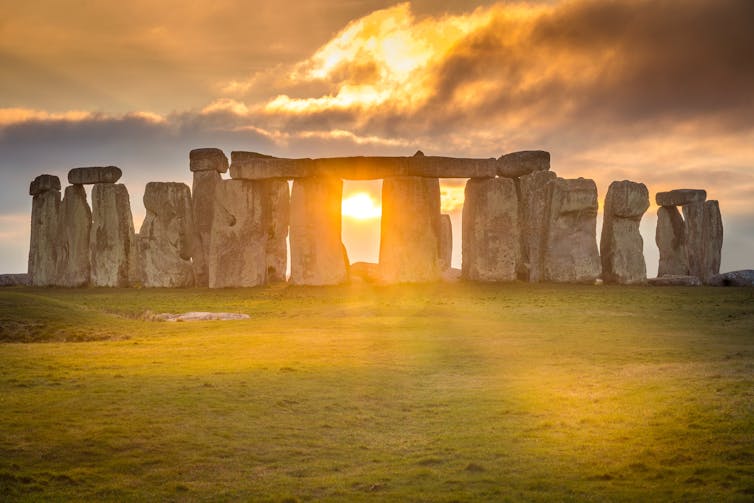
As communities developed into cities, empires and states, and societies became more segregated, time became more important and was divided into hours.
The Sumerians (4100-1750BC) based around Mesopotamia (modern-day Iraq) calculated that the day was approximately 24 hours and that each hour was 60 minutes long. They used the Sun, stars and water clocks to keep track of time. Water clocks used the gradual flow of water from one container to another to measure time.

The ancient Egyptians also introduced a 24-hour time system around 1550-1069BC. But the length of these “hours” varied depending on the time of year – longer in summertime than winter. These measures of time were based on the Sun, with 12 parts during daylight, and another 12 parts through the night. The Egyptians started using a sundial to represent this time system around 1000-800BC. Since sundials cannot tell the time at night, they used water clocks after dark.
In Europe, the development of time measurement gets a bit foggy over the centuries around AD700-1300AD, as all time-telling devices are bundled into the same Latin word, Horologium, in written European records.
The economist and historian David S. Landes claims in his book, Revolution in Time, that monastic Christian prayers were more rigid compared with Judaism and Islam, using the heavens to dictate what time to pray across the Catholic church’s seven set canonical hours. For example, sext was supposed to be recited at midday. The time period between these canonical prayers became equal in length because of the rigidity of prayer times.
Timepieces may also have been more important in central Europe, because the cloudier weather would have made it harder to track the Sun and stars.
While we can’t be certain from historical records if it was monks who made the first mechanical clocks, we do know that they first appeared in the 14th century.
Their first mention is in the Italian physician, astronomer and mechanical engineer Giovanni de Dondi’s treatise Tractatus Astrarii, or Planetarium. De Dondi states that early clocks used gravity as their power source and were driven by weights.

These weren’t the accurate clocks we see today – they probably kept time to within 15-30 minutes a day. These early clocks started popping up in city centres but, since they did not have a face, they used bells to signal the hours. These signals began to organise the market times and administrative needs of each city.
Coiled springs as a method of releasing energy for clocks began to appear in Europe in the 15th century. This didn’t do anything to improve accuracy, but it could reduce the size of the clock. So, time became more of a personal as well as status object – you only have to look at oil paintings where subject’s watches are proudly displayed.
The Dutch scientist Christian Huygens first applied the pendulum to a clock in about 1656. This bolstered their accuracy to within 15 seconds a day, because each swing now took almost exactly the same time to complete.
As a result, time could be used more accurately in scientific observations, including of the stars. It also meant that clocks could now show an accurate minute hand.

Elsewhere in the world, some time-tracking devices date back many centuries earlier. In the 13th century, there is evidence of the use of gears to control the movement of components in Arabic astrolabes – devices that could calculate time and help navigators determine their position. And long before that, the Ancient Greek Antikythera mechanism, regarded as the world’s first computer, is dated at around 100BC (having been discovered in AD1901). These are both devices that predicted the motions of the planets.
Meanwhile in China, there was Su Song’s astronomical clock – dated to AD1088 – which was powered by water. So, while the clock was invented in Europe in the 14th century, Arabic and Chinese societies were far more technologically advanced at this time than their western Christian counterparts.
Today, wherever we are in the world, time is a unified construct – and the search for ever-more precise measurements continues. In 2021, scientists identified a new shortest timespan, the zeptosecond, which is how long it takes for a particle of light to pass through a molecule of hydrogen.
In modern society, time is usually organised to the minute or even second (think of train timetables, how we document transactions, or record setting in sports). This internalises within ourselves an obsession with being on time. People arrange to meet a friend, and hurry to the destination when they’re a minute or too late. But really, what’s a few minutes between friends?
Jaq Prendergast does not work for, consult, own shares in or receive funding from any company or organisation that would benefit from this article, and has disclosed no relevant affiliations beyond their academic appointment.
My annual reminder that January 1st is Public Domain Day, and this year copyright has ended for books, movies, and music first published in the U.S. in 1928, so you are free to use, reprint, quote, remix, and adapt them without permission or payment.
Notable 1928 literary works now in the public domain include Virginia Woolf’s Orlando, D.H. Lawrence’s Lady Chatterley’s Lover, A.A. Milne’s The House at Pooh Corner, Radclyffe Hall’s The Well of Loneliness, William Butler Yeats’ The Tower, and Robert Frost’s West-Running Brook, to name just a few. The full texts of the 1928 books that have been scanned by the Internet Archive, Hathi Trust, Google Books, and other digital archives should now be publicly available on their websites.
These 1928 works should have gone into the public domain in 1984, after 56 years, but retroactive copyright extensions changed that date first to 2004 and then to 2024, thanks to the 1998 Sony Bono Copyright Term Extension Act, which extended copyright terms of works published before 1978 from 75 to 95 years and works created on or after that date to the life of the author plus 70 years. For many years the public domain in the U.S. was frozen, including only works published through 1922, but since 2019, thousands of works have been released into the public domain each New Year’s Day.
Visit the Public Domain Day 2024 website created by Jennifer Jenkins from Duke Law’s Center for the Study of the Public Domain to read important news and information about copyright and the public domain and to explore some of the 1928 works that you can now use as you like.

In 2024, former President Donald Trump will face some of his greatest challenges: criminal court cases, primary opponents and constitutional challenges to his eligibility to hold the office of president again. The Colorado Supreme Court has pushed that latter piece to the forefront, ruling on Dec. 19, 2023, that Trump cannot appear on Colorado’s 2024 presidential ballot because of his involvement in the Jan. 6, 2021, insurrection.
The reason is the 14th Amendment to the Constitution, ratified in 1868, three years after the Civil War ended. Section 3 of that amendment wrote into the Constitution the principle President Abraham Lincoln set out just three months after the first shots were fired in the Civil War. On July 4, 1861, he spoke to Congress, declaring that “when ballots have fairly, and constitutionally, decided, there can be no successful appeal back to bullets.”
The text of Section 3 of the 14th Amendment states, in full:
“No person shall be a Senator or Representative in Congress, or elector of President and Vice-President, or hold any office, civil or military, under the United States, or under any State, who, having previously taken an oath, as a member of Congress, or as an officer of the United States, or as a member of any State legislature, or as an executive or judicial officer of any State, to support the Constitution of the United States, shall have engaged in insurrection or rebellion against the same, or given aid or comfort to the enemies thereof. But Congress may by a vote of two-thirds of each House, remove such disability.”
To me as a scholar of constitutional law, each sentence and sentence fragment captures the commitment made by the nation in the wake of the Civil War to govern by constitutional politics. People seeking political and constitutional changes must play by the rules set out in the Constitution. In a democracy, people cannot substitute force, violence or intimidation for persuasion, coalition building and voting.
The first words of Section 3 describe various offices that people can only hold if they satisfy the constitutional rules for election or appointment. The Republicans who wrote the amendment repeatedly declared that Section 3 covered all offices established by the Constitution. That included the presidency, a point many participants in framing, ratifying and implementation debates over constitutional disqualification made explicitly, as documented in the records of debate in the 39th Congress, which wrote and passed the amendment.
Senators, representatives and presidential electors are spelled out because some doubt existed when the amendment was debated in 1866 as to whether they were officers of the United States, although they were frequently referred to as such in the course of congressional debates.
No one can hold any of the offices enumerated in Section 3 without the power of the ballot. They can only hold office if they are voted into it – or nominated and confirmed by people who have been voted into office. No office mentioned in the first clause of Section 3 may be achieved by force, violence or intimidation.
The next words in Section 3 describe the oath “to support [the] Constitution” that Article 6 of the Constitution requires all office holders in the United States to take.
The people who wrote Section 3 insisted during congressional debates that anyone who took an oath of office, including the president, were subject to Section 3’s rules. The presidential oath’s wording is slightly different from that of other federal officers, but everyone in the federal government swears to uphold the Constitution before being allowed to take office.
These oaths bind officeholders to follow all the rules in the Constitution. The only legitimate government officers are those who hold their offices under the constitutional rules. Lawmakers must follow the Constitution’s rules for making laws. Officeholders can only recognize laws that were made by following the rules – and they must recognize all such laws as legitimate.
This provision of the amendment ensures that their oaths of office obligate officials to govern by voting rather than violence.

Section 3 then says people can be disqualified from holding office if they “engaged in insurrection or rebellion.” Legal authorities from the American Revolution to the post-Civil War Reconstruction understood an insurrection to have occurred when two or more people resisted a federal law by force or violence for a public, or civic, purpose.
Shay’s Rebellion, the Whiskey Insurrection, Burr’s Rebellion, John Brown’s Raid and other events were insurrections, even when the goal was not overturning the government.
What these events had in common was that people were trying to prevent the enforcement of laws that were consequences of persuasion, coalition building and voting. Or they were trying to create new laws by force, violence and intimidation.
These words in the amendment declare that those who turn to bullets when ballots fail to provide their desired result cannot be trusted as democratic officials. When applied specifically to the events on Jan. 6, 2021, the amendment declares that those who turn to violence when voting goes against them cannot hold office in a democratic nation.
The last sentence of Section 3 announces that forgiveness is possible. It says “Congress may by a vote of two-thirds of each House, remove such disability” – the ineligibility of individuals or categories of people to hold office because of having participated in an insurrection or rebellion.
For instance, Congress might remove the restriction on office-holding based on evidence that the insurrectionist was genuinely contrite. It did so for repentant former Confederate General James Longstreet .
Or Congress might conclude in retrospect that violence was appropriate, such as against particularly unjust laws. Given their powerful anti-slavery commitments and abolitionist roots, I believe that Republicans in the House and Senate in the late 1850s would almost certainly have allowed people who violently resisted the fugitive slave laws to hold office again. This provision of the amendment says that bullets may substitute for ballots and violence for voting only in very unusual circumstances.
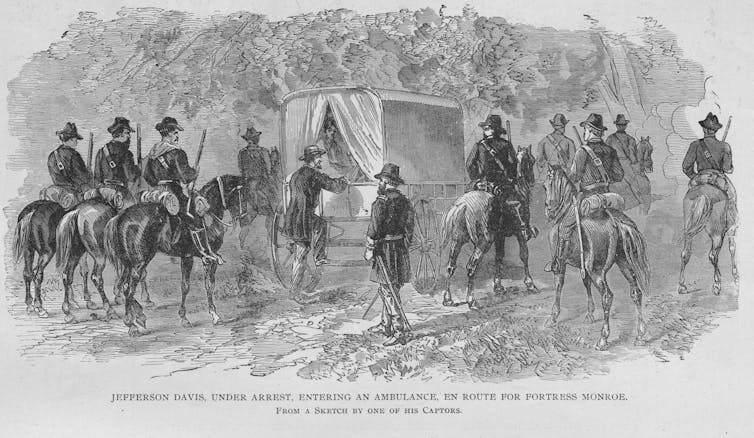
Taken as a whole, the structure of Section 3 leads to the conclusion that Donald Trump is one of those past or present government officials who by violating his oath of allegiance to the constitutional rules has forfeited his right to present and future office.
Trump’s supporters say the president is neither an “officer under the United States” nor an “officer of the United States” as specified in Section 3. Therefore, they say, he is exempt from its provisions.
But in fact, both common sense and history demonstrate that Trump was an officer, an officer of the United States and an officer under the United States for constitutional purposes. Most people, even lawyers and constitutional scholars like me, do not distinguish between those specific phrases in ordinary discourse. The people who framed and ratified Section 3 saw no distinction. Exhaustive research by Trump supporters has yet to produce a single assertion to the contrary that was made in the immediate aftermath of the Civil War. Yet scholars John Vlahoplus and Gerard Magliocca are daily producing newspaper and other reports asserting that presidents are covered by Section 3.
Significant numbers of Republicans and Democrats in the House and Senate agreed that Donald Trump violated his oath of office immediately before, during and immediately after the events of Jan. 6, 2021. Most Republican senators who voted against his conviction did so on the grounds that they did not have the power to convict a president who was no longer in office. Most of them did not dispute that Trump participated in an insurrection. A judge in Colorado also found that Trump “engaged in insurrection,” which was the basis for the state’s Supreme Court ruling barring him from the ballot.
Constitutional democracy is rule by law. Those who have demonstrated their rejection of rule by law may not apply, no matter their popularity. Jefferson Davis participated in an insurrection against the United States in 1861. He was not eligible to become president of the U.S. four years later, or to hold any other state or federal office ever again. If Davis was barred from office, then the conclusion must be that Trump is too – as a man who participated in an insurrection against the United States in 2021.
Mark A. Graber does not work for, consult, own shares in or receive funding from any company or organization that would benefit from this article, and has disclosed no relevant affiliations beyond their academic appointment.
Christmas and copyright go together as often gingerbread cookies and milk. Here's just five ways that copyright has changed Christmas.
The post 5 Ways Copyright Has Changed Christmas appeared first on Plagiarism Today.
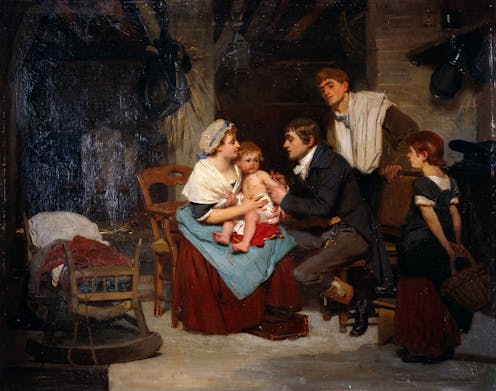
As the 1906 UK general election results rolled in, it became clear that the Conservative party, after 11 years in power, had suffered one of the most disastrous defeats in its history. Of 402 Conservative MPs, 251 lost their seats, including their candidate for prime minister, defeated on a 22.5% swing against him in the constituency he had held for two decades.
Rising food prices, unpopular taxes and an opposition that promised to spend heavily on an expanded welfare state all contributed to the Tory downfall that year. But something else had tipped the opposition Liberal landslide over the edge – compulsory vaccination.
Anti-vaccination campaigner Arnold Lupton had taken Sleaford in Lincolnshire for the Liberals on a 12% swing and immediately started his parliamentary campaign to abolish compulsory vaccination against smallpox, a public health policy that had been in place in England and Wales since 1853 (with Scottish and Irish legislation following suit in later years).
Hardly a single Conservative MP was an anti-vaccinator, but 174 of the 397 Liberal MPs in the new parliament signed Lupton’s petition.
Their attempt at changing the law was unsuccessful, but this flexing of parliamentary muscle by the anti-vaccinators persuaded the new Liberal government that the most expedient option was to reach a compromise with its backbench rebels.
In 1907, the law was changed to permit quick and easy opt-out by parents. Vaccination of all babies against smallpox remained theoretically compulsory until 1946, but in practice, it was now optional. A five-decade-long campaign, in the streets, the courts and finally parliament, had resulted in victory for the opponents of vaccination.
This is a sobering story for those of us who are researchers, medical professionals or public health activists campaigning against the spread of vaccine hesitancy in the modern world.
The success of vaccination in saving millions of lives, not just from smallpox but a host of other diseases, seems so obvious that the case scarcely needs to be made. And yet it does, as just a cursory glance at social, even at times mainstream, media will reveal.
In response to this tide of dangerous disinformation, vaccine advocacy work often focuses on issues such as the lack of public comprehension of scientific concepts of “relative risk” and “efficacy”, and the connections of the anti-vaccine activists to more general conspiracy theories and extreme religious or political movements.
The conclusion of many vaccine advocacy pieces is often that we must simply educate the public better while simultaneously cutting the flow of disinformation, yet this has often proved to be an uphill struggle. Why? Can vaccine advocates learn anything from the historic defeat of 1906?
A recently published resource of Victorian anti-vaccination “street literature” seeks to contribute to this effort by providing free access to 3.5 million words from 133 documents, ranging from short pamphlets to longer publications over the period 1854-1906.
What the 133 sources have in common is that they were all produced for public consumption, designed to strengthen or maintain the beliefs of the converted while reaching out for new converts. Existing outside the conventional publishing industry, this street literature was the social media of the Victorian era.
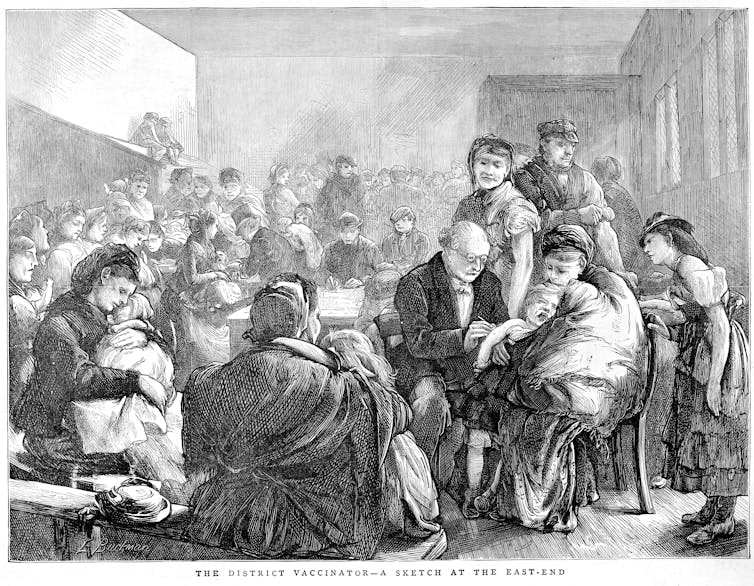
Computational analysis of these texts reveals anti-vaccination themes that are very similar to those of today. For instance, doubts about the effectiveness of vaccines, what they’re made of and their safety, feature prominently.
Other common themes include complaints that civil liberties are infringed by compulsory vaccination, alongside conspiracy theories of government cover-ups, general distrust of the medical profession, and an orientation towards alternative medicine.
What changes is the detail. For instance, fear of the inadvertent introduction of syphilis, tuberculosis and skin diseases, as very occasionally happened in Victorian times, may be compared to the blood clots issue with the COVID vaccine.
Other more spurious scare stories, such as an association between vaccination and tooth decay or mental illness have their parallels in the discredited autism claims of the present day. Likewise, modern conspiracy theories about big pharma have their Victorian parallel in allegations of medical profiteering from vaccination fees.
This study of the Victorian anti-vaxxers shows us that there are indeed recurrent fears more than two centuries old. But it also teaches us that some of the motivations of vaccine hesitancy stem from social, political and religious beliefs that are equally deep in time and often deeply held.

For example, William Tebb, one of the most prominent anti-vaxxers of Victorian times campaigned with equal energy on a whole raft of causes, from women’s suffrage to the abolition of slavery via vegetarianism, animal rights and mystical religion.
For Tebb and many of his followers, these were intimately connected causes. To reach the root of the problem, we need to untangle these connections in sensitive ways that go beyond conventional public engagement.
The project described in this article is funded by the UK Economic & Social Research Council.
Chris Sanderson received funding from the UK Economic & Social Research Council for this project.
Alice Deignan does not work for, consult, own shares in or receive funding from any company or organisation that would benefit from this article, and has disclosed no relevant affiliations beyond their academic appointment.

A recent investigation from the Australian Strategic Policy Institute (ASPI) has revealed an extensive network of YouTube channels promoting pro-Chinese and anti-US public opinion in the English-speaking world.
The operation is well-coordinated, using generative AI to rapidly produce and publish content, while deftly exploiting YouTube’s algorithmic recommendation system.
Operation “Shadow Play” involves a network of at least 30 YouTube channels with about 730,000 subscribers. At the time of writing this article the channels had some 4,500 videos between them, with about 120 million views.
According to ASPI, the channels gained audiences by using AI algorithms to cross-promote each other’s content, thereby boosting visibility. This is concerning as it allows state messaging to cross borders with plausible deniability.
The network of videos also featured an AI avatar created by British artificial intelligence company Synthesia, according to the report, as well as other AI-generated entities and voiceovers.
While it’s not clear who is behind the operation, investigators say the controller is likely Mandarin-speaking. After profiling the behaviour, they concluded it doesn’t match that of any known state actor in the business of online influence operations. Instead, they suggest it might be a commercial entity operating under some degree of state direction.
These findings double as the latest evidence that advanced influence operations are evolving faster than defensive measures.
One clear parallel between the Shadow Play operation and other influence campaigns is the use of coordinated networks of inauthentic social media accounts, and pages amplifying the messaging.
For example, in 2020 Facebook took down a network of more than 300 Facebook accounts, pages and Instagram accounts that were being run from China and posting content about the US election and COVID pandemic. As was the case with Shadow Play, these assets worked together to spread content and make it appear more popular than it was.
The current disclosure requirements around sponsored content have some glaring gaps when it comes to addressing cross-border influence campaigns. Most Australian consumer protection and advertising regulation focuses on commercial sponsorships rather than geopolitical conflicts of interest.
Platforms such as YouTube prohibit deceptive practices in their stated rules. However, identifying and enforcing violations is difficult with foreign state-affiliated accounts that conceal who is pulling their strings.
Determining what is propaganda, as opposed to free speech, raises difficult ethical questions around censorship and political opinions. Ideally, transparency measures shouldn’t unduly restrict protected speech. But viewers still deserve to understand an influencer’s incentives and potential biases.
Possible measures could include clear disclosures when content is affiliated directly or indirectly with a foreign government, as well as making affiliation and location data more visible on channels.
As technologies become more sophisticated, it’s becoming harder to discern what agenda or conflict of interest may be shaping the content of a video.
Discerning viewers can gain some insight by looking into the creator(s) behind the content. Do they provide information on who they are, where they’re based and their background? A lack of clarity may signal an attempt to obscure their identity.
You can also assess the tone and goal of the content. Does it seem to be driven by a specific ideological argument? What is the poster’s ultimate aim: are they just trying to get clicks, or are they persuading you into believing their viewpoint?
Check for credibility signals, such as what other established sources say about this creator or their claims. When something seems dubious, rely on authoritative journalists and fact-checkers.
And make sure not to consume too much content from any single creator. Get your information from reliable sources across the political spectrum so you can take an informed stance.
The advancement of AI could exponentially amplify the reach and precision of coordinated influence operations if ethical safeguards aren’t implemented. At its most extreme, the unrestricted spread of AI propaganda could undermine truth and manipulate real-world events.
Propaganda campaigns may not stop at trying to shape narratives and opinions. They could also be used to generate hyper-realistic text, audio and image content aimed at radicalising individuals. This could greatly destabilise our societies.
We’re already seeing the precursors of what could become AI psy-ops with the ability to spoof identities, surveil citizens en masse, and automate disinformation production.
Without applying an ethics or oversight framework to content moderation and recommendation algorithms, social platforms could effectively act as misinformation mega-amplifiers optimised for watch-time, regardless of the consequences.
Over time, this may erode social cohesion, upend elections, incite violence and even undermine our democratic institutions. And unless we move quickly, the pace of malicious innovation may outstrip any regulatory measures.
It’s more important than ever to establish external oversight to make sure social media platforms work for the greater good, and not just short-term profit.
David Tuffley does not work for, consult, own shares in or receive funding from any company or organisation that would benefit from this article, and has disclosed no relevant affiliations beyond their academic appointment.

Despite the holiday season’s calls for joy and peace, religious strife continues in many places. While the United States has a great deal of litigation and controversy over religion’s place in public life, it has largely avoided violence. Yet our society often seems unprepared to talk constructively about this contentious topic, especially in schools.
According to the IDEALS survey of college students on 122 U.S. campuses, conducted by researchers at North Carolina State University, Ohio State University and the nonprofit Interfaith America, just 32% of students said they had developed the skills “to interact with people of diverse beliefs.” Although almost three-quarters of students spent time learning about people of different races, ethnicities or countries, less than half of them reported learning about various religions. Most students received “C” grades or below on the survey’s religious literacy quiz.
Objective education about the world’s religions has the potential to foster tolerance and understanding, and various research groups provide guidelines for religious literacy education. Yet the study of religion may be hindered by hesitation about what is and isn’t legal in public classrooms – a topic I write about often as a professor of law and education, with a particular interest in these fields’ relationships to religion.
Other countries also face challenges in deciding what kind of religion-related instruction can or can’t be legally taught in public schools, and each deals with the question in different ways.

Though there have been many Supreme Court cases over issues of church and state in public schools, most deal with the First Amendment freedoms of students, staff and parents rather than what’s officially taught in class.
There has been relatively little litigation about what teachers can and can’t instruct students in matters that touch on religion. Two of the exceptions involved lessons about evolution: one decided in 1968, the other in 1987. In both cases, the Supreme Court upheld educators’ right to teach evolution, rather than the biblical accounts of creation, to explain human origins.
Federal trial courts in Mississippi and Florida banned courses in the 1990s that included instruction about the New Testament, ruling that the way they were taught crossed a line and violated the establishment clause of the U.S. Constitution. However, this was because the courts determined instruction was being given from a Christian perspective. The court in Florida did allow teaching about the Hebrew scriptures, because the focus was on the texts’ cultural and literary significance.
In the Supreme Court’s closest response to the question of teaching about religion in public schools, 1963’s School District of Abington Township v. Schempp, eight of the nine justices agreed that state-sponsored prayer and Bible reading in public schools violates the establishment clause. Yet the court recognized that “the Bible is worthy of study for its literary and historic qualities. Nothing we have said here indicates that such study of the Bible or of religion, when presented objectively as part of a secular program of education, may not be effected consistently with the First Amendment.”
The court’s decision “plainly does not foreclose teaching about the Holy Scriptures or about the differences between religious sects in classes in literature or history,” Justice William Brennan added in a concurrence. Thus, consistent with religious literacy programs’ approach, public schools can teach about religion, but not in ways that seek to instill systems of belief.
To place the issue in perspective, it is worth highlighting other countries’ approaches to teaching about religion in the classroom – the focus of a book I recently edited.
At one end of the 18 countries examined in the book, educators in Mexico impose significant restrictions on what can be taught about faith-based beliefs. According to the Mexican Constitution, “State education shall be maintained entirely apart from any religious doctrine.” However, it does allow religious institutions to provide faith-based education through the private schools they sponsor.
Most nations the book analyzes are more open to teaching about religion in public schools as long as instruction remains objective and does not indoctrinate students. Australia, Brazil, Canada, Hungary, Italy, the Netherlands, Poland, South Africa and Sweden all adopt this approach in varying degrees.
For example, according to the Brazilian Constitution, optional religious education should be offered during the day for elementary students. The country’s National Education Act describes this as a way of “ensuring respect for Brazil’s religious cultural diversity, and any form of proselytism is prohibited.”

Australia allows nondenominational classes about religion to help students understand the “influence of religion in life and society and the variety of beliefs by which people live.” In addition, it permits faith-based student clubs, as well as religious seminars that amount to no more than one half day per term. Parents can ask that their children be excused, or students may participate in ethics courses instead.
At the other end, England, Malaysia and Turkey mandate teaching about religion in public schools, though British parents may exempt their children. England’s Department for Children, Schools and Families strongly encourages that instruction include multiple religious perspectives, while classes in the other two countries are allowed to be more from faith-based perspectives.
Malaysia, which declares Islam the official religion, mandates faith-based instruction on Islam for Muslim students. Non-Muslims must attend moral studies classes. Turkey, meanwhile, requires religious culture and moral knowledge courses for grades 4-12 that focus on Islam. Parents who belong to other religions have the right to exempt their children from these classes.
What happens in public schools in the U.S. today will significantly shape tomorrow’s society. I believe encouraging teaching about religion can help America’s rapidly diversifying population to understand and respect others’ beliefs or lack thereof. Discussing religions in an inclusive, objective and academic way can certainly be challenging in a classroom, as there is a fine line between teaching about it and proselytizing – but not doing so has risks as well.
Charles J. Russo does not work for, consult, own shares in or receive funding from any company or organization that would benefit from this article, and has disclosed no relevant affiliations beyond their academic appointment.
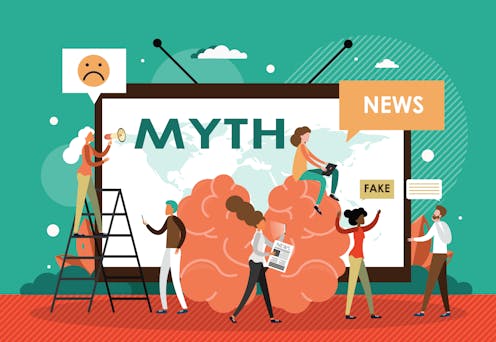
The global anti-vaccine movement and vaccine hesitancy that accelerated during the COVID-19 pandemic show no signs of abating.
According to a survey of U.S. adults, Americans in October 2023 were less likely to view approved vaccines as safe than they were in April 2021. As vaccine confidence falls, health misinformation continues to spread like wildfire on social media and in real life.
I am a public health expert in health misinformation, science communication and health behavior change.
In my view, we cannot underestimate the dangers of health misinformation and the need to understand why it spreads and what we can do about it. Health misinformation is defined as any health-related claim that is false based on current scientific consensus.
Vaccines are the No. 1 topic of misleading health claims. Some common myths about vaccines include:
Their supposed link with human diagnoses of autism. Multiple studies have discredited this claim, and it has been firmly refuted by the World Health Organization, the National Academies of Sciences, Engineering and Medicine, the American Academy of Pediatrics and the Centers for Disease Control and Prevention.
Concerns with the COVID-19 vaccine leading to infertility. This connection has been debunked through a systematic review and meta-analysis, one of the most robust forms of synthesizing scientific evidence.
Safety concerns about vaccine ingredients, such as thimerosal, aluminum and formaldehyde. Extensive studies have shown these ingredients are safe when used in the minimal amounts contained in vaccines.
Vaccines as medically unnecessary to protect from disease. The development and dissemination of vaccines for life-threatening diseases such as smallpox, polio, measles, mumps, rubella and the flu has saved millions of lives. It also played a critical role in historic increases in average life expectancy – from 47 years in 1900 in the U.S. to 76 years in 2023.
Beliefs in such myths have come at the highest cost.
An estimated 319,000 COVID-19 deaths that occurred between January 2021 and April 2022 in the U.S. could have been prevented if those individuals had been vaccinated, according to a data dashboard from the Brown University School of Public Health. Misinformation and disinformation about COVID-19 vaccines alone have cost the U.S. economy an estimated US$50 million to $300 million per day in direct costs from hospitalizations, long-term illness, lives lost and economic losses from missed work.
Though vaccine myths and misunderstandings tend to dominate conversations about health, there is an abundance of misinformation on social media surrounding diets and eating disorders, smoking or substance use, chronic diseases and medical treatments.
My team’s research and that of others show that social media platforms have become go-to sources for health information, especially among adolescents and young adults. However, many people are not equipped to maneuver the maze of health misinformation.
For example, an analysis of Instagram and TikTok posts from 2022 to 2023 by The Washington Post and the nonprofit news site The Examination found that the food, beverage and dietary supplement industries paid dozens of registered dietitian influencers to post content promoting diet soda, sugar and supplements, reaching millions of viewers. The dietitians’ relationships with the food industry were not always made clear to viewers.
Studies show that health misinformation spread on social media results in fewer people getting vaccinated and can also increase the risk of other health dangers such as disordered eating and unsafe sex practices and sexually transmitted infections. Health misinformation has even bled over into animal health, with a 2023 study finding that 53% of dog owners surveyed in a nationally representative sample report being skeptical of pet vaccines.
One major reason behind the spread of health misinformation is declining trust in science and government. Rising political polarization, coupled with historical medical mistrust among communities that have experienced and continue to experience unequal health care treatment, exacerbates preexisting divides.
The lack of trust is both fueled and reinforced by the way misinformation can spread today. Social media platforms allow people to form information silos with ease; you can curate your networks and your feed by unfollowing or muting contradictory views from your own and liking and sharing content that aligns with your existing beliefs and value systems.
By tailoring content based on past interactions, social media algorithms can unintentionally limit your exposure to diverse perspectives and generate a fragmented and incomplete understanding of information. Even more concerning, a study of misinformation spread on Twitter analyzing data from 2006 to 2017 found that falsehoods were 70% more likely to be shared than the truth and spread “further, faster, deeper and more broadly than the truth” across all categories of information.
The lack of robust and standardized regulation of misinformation content on social media places the difficult task of discerning what is true or false information on individual users. We scientists and research entities can also do better in communicating our science and rebuilding trust, as my colleague and I have previously written. I also provide peer-reviewed recommendations for the important roles that parents/caregivers, policymakers and social media companies can play.
Below are some steps that consumers can take to identify and prevent health misinformation spread:
Check the source. Determine the credibility of the health information by checking if the source is a reputable organization or agency such as the World Health Organization, the National Institutes of Health or the Centers for Disease Control and Prevention. Other credible sources include an established medical or scientific institution or a peer-reviewed study in an academic journal. Be cautious of information that comes from unknown or biased sources.
Examine author credentials. Look for qualifications, expertise and relevant professional affiliations for the author or authors presenting the information. Be wary if author information is missing or difficult to verify.
Pay attention to the date. Scientific knowledge by design is meant to evolve as new evidence emerges. Outdated information may not be the most accurate. Look for recent data and updates that contextualize findings within the broader field.
Cross-reference to determine scientific consensus. Cross-reference information across multiple reliable sources. Strong consensus across experts and multiple scientific studies supports the validity of health information. If a health claim on social media contradicts widely accepted scientific consensus and stems from unknown or unreputable sources, it is likely unreliable.
Question sensational claims. Misleading health information often uses sensational language designed to provoke strong emotions to grab attention. Phrases like “miracle cure,” “secret remedy” or “guaranteed results” may signal exaggeration. Be alert for potential conflicts of interest and sponsored content.
Weigh scientific evidence over individual anecdotes. Prioritize information grounded in scientific studies that have undergone rigorous research methods, such as randomized controlled trials, peer review and validation. When done well with representative samples, the scientific process provides a reliable foundation for health recommendations compared to individual anecdotes. Though personal stories can be compelling, they should not be the sole basis for health decisions.
Talk with a health care professional. If health information is confusing or contradictory, seek guidance from trusted health care providers who can offer personalized advice based on their expertise and individual health needs.
When in doubt, don’t share. Sharing health claims without validity or verification contributes to misinformation spread and preventable harm.
All of us can play a part in responsibly consuming and sharing information so that the spread of the truth outpaces the false.
Monica Wang receives funding from the National Institutes of Health.
Tensions have been running high at many universities around the world since the Hamas attack on Israel on October 7 and the subsequent Israeli assault on Gaza. In the US, protests and solidarity events have been met with varied responses from university administrations. Some institutions are now facing federal investigation over incidents of alleged antisemitism and Islamophobia.
There’s been political fallout too: in early December, the president of the University of Pennsylvania stood down after coming under pressure following her answers to a hearing in Congress about antisemitism on campus.
In the first of two episodes exploring how the war is affecting life at universities, The Conversation Weekly podcast hears about what’s been happening at one American public college campus.
David Mednicoff says his department at the University of Massachusetts, Amherst, tends to have the students who are “the most directly involved in issues around the Middle East, from different perspectives.” Mednicoff is chair of the university’s Department of Judaic and Near Eastern Studies and an associate professor of Middle Eastern studies and public policy.
Speaking to The Conversation Weekly podcast about the reaction on campus to the Israel-Gaza war, he said he’s been working to find ways of bridging divides, including putting on events designed to provide background to the conflict. Mednicoff believes that students should be able to listen to perspectives that can challenge them, “sometimes even to the core of their identity”.
It is reasonable for a Palestinian Arab to hear an Israeli-Jewish student share their sadness and fear in light of the October 7 massacres. It is reasonable for a pro-Israeli activist to appreciate that there’s a long history and even more important recent history of demeaning of Palestinian rights, particularly in the occupied territories.
Mednicoff says the campus branch of Students for Justice for Palestine has been “louder than pro-Israel folks in terms of campus political discourse”. Pro-Palestinian protests, including a sit-in at a university administrative building where 57 people were arrested, have called for a ceasefire in Gaza. In a separate incident, a student was arrested and charged after allegedly attacking a Jewish student on campus.
Universities have come under fire from those – both pro-Israeli and pro-Palestinian – who think their leadership should take a stronger stance during the Israel-Gaza conflict. But Mednicoff thinks it isn’t the role of a university to do that. “In general, I think that it is ill advised for universities to take political positions on global issues,” he said. And because of the current climate for higher education, particularly in the US, he thinks it’s also a political choice for universities to try and foster well-informed, open debate.
Universities, I think all over the world, but certainly in the United States are themselves under a good bit of attack, by outside groups who think that universities either should push a particular perspective or they shouldn’t be places where broad free speech is allowed if it goes against what they would conceive as particular guardrails.
You can listen to the full interview with David Mednicoff on The Conversation Weekly, plus an interview with Naomi Schalit, senior editor for politics and democracy at The Conversation in the US.
This episode of The Conversation Weekly was written and produced by Gemma Ware, and Mend Mariwany, with assistance from Katie Flood. Sound design was by Eloise Stevens, and our theme music is by Neeta Sarl.
Newsclips in this episode from NBC News and CBS News.
You can find us on X, formerly known as Twitter @TC_Audio, on Instagram at theconversationdotcom or via email. You can also subscribe to The Conversation’s free daily email here.
Listen to The Conversation Weekly via any of the apps listed above, download it directly via our RSS feed or find out how else to listen here.
David Mednicoff does not work for, consult, own shares in or receive funding from any company or organisation that would benefit from this article, and has disclosed no relevant affiliations beyond their academic appointment.

A recent report noting that funding for Ontario’s universities is “low when compared with support in other provinces” points to underfunding as a serious problem in the province’s post-secondary sector.
Funding quickly raises the question of value: what is it that universities offer that warrants public investment?
Much of my own research has posited that universities have a responsibility to contribute to the public good and to equity.
Academic research and reports authored by educational, not-for-profit and governmental organizations confirm that universities are integral to democratic societies.
The question of the purposes of universities is both long-standing and one that has elicited many perspectives. Recent global attention to both systemic forms of injustice and increasingly urgent climate crises underscore the complexity of considering universities’ obligations to public life.
I contend that the central contribution of post-secondary institutions, related to graduate and undergraduate education, is to prepare students to attend to the practices of living together well — with the capacities to recognize inequity and advance equity, in field-specific settings and a range of communities.
While many faculty members might agree with the idea that a university education will ideally respond to professional, intellectual and public and equity-related priorities, the conversation can quickly become contested.
Indeed, implementation of this idea does present challenges. And yet — graduates will enter a world in which systemic forms of inequity are present in a variety of settings and sectors. The likelihood of a university graduate encountering inequity in their chosen profession or field is less a question of if than when and how.
Likewise, the view that universities can educate students who can contribute to a more equitable future offers a constructive and bold response to the question of what a university education is for.
Universities can and do prepare graduates to contribute to their professions, to economic interests, and to the public good. The economic, civic and intellectual ends of a university education do not need to be placed in opposition to one another, or set up as binary or discreet.
Increasingly, universities and accreditation bodies alike are affirming the multiple and overlapping interests a university degree supports, including the importance of curricular attention to diversity and equity.
One obvious concrete end of a university education is the intellectual endeavour, which typically includes the acquisition of knowledge and the life of the mind.
Civic ends constitute a second purpose of a university education: ideally, students will be able to consider how a degree prepares them to think and act as citizens and participate in key public decisions.
Read more: Canadian engineers call for change to their private 'iron ring' ceremony steeped in colonialism
Those in industry, provincial and federal governments, and the post-secondary sector stress the importance of preparing students for the labour market and for employment.
Studies have demonstrated that students, whether in professional disciplines (such as nursing or engineering) or those not governed by accreditation bodies (like philosophy or film) will make significant economic and civic contributions, whether in the public sector or other industries.
Directly asserting that universities have an obligation to contribute to the practices of living together well with an eye toward equity can quickly raise objections from within and outside of higher education.
There are many who are most comfortable with the belief that universities are neutral institutions and that academic programs ought to maintain this neutrality via a clear and often specific reliance on rational, discipline-specific thought or methods. In fact, in providing content in academic programs and specific courses, faculty members endorse a way of seeing the world.
Faculty members teach in ways that, implicitly or explicitly and intentionally or not, variously endorse the status quo and existing forms of injustice, or call attention to the need for equity and provide an education that speaks to this need.
Read more: In times of racial injustice, university education should not be 'neutral'
Time in the classroom and in conversation with faculty members and other students will shape habits, inform priorities and orient students toward what is possible and desirable.
Graduates’ choices and actions will nearly always have a bearing on how people live. Whether in sociology or biology or mathematics, courses will orient students in how to understand the world in which they live, and also in regard to what their responsibilities are to that world in the context of their chosen fields.
We can do so in ways that underscore the hallmarks of intellectual engagement: curiosity, openness to various perspectives, attention to context, and listening to those with whom we disagree.
Universities are places for deliberation, inquiry, curiosity and investigation. In teaching students, university faculty have the privilege of asking why, how and what for in regard to numerous settings and situations, and the pleasure of bringing knowledge and different perspectives to bear on how classroom learning affects our society.
We live in a world in which systemic forms of inequity persist. In designing courses and academic programs, faculty have an opportunity to engage students with field-specific knowledge and to attend to the practical and ethical uses of that knowledge once students graduate.
For all these reasons, a university education at its best will be attentive to the public good and to equity, and to civic, intellectual and employment ends.
Jennifer S Simpson does not work for, consult, own shares in or receive funding from any company or organisation that would benefit from this article, and has disclosed no relevant affiliations beyond their academic appointment.
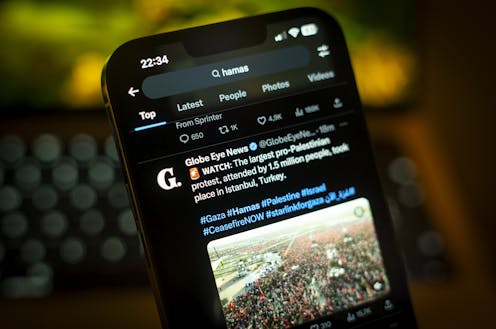
As the war between Israel and Hamas drags on, many on both sides have taken to social media to gather information and air their outrage. The impulse to do so is understandable: Political activism on social media provides people with an emotional outlet and gives them a sense that they can do something. The war is awful, and following it generates a sharp psychological need to get involved and do something.
In the past few years, my colleagues and I at UMass Boston’s Applied Ethics Center have been studying the ethics of emerging technologies. I believe that political activism on social media is a counterproductive and sometimes even dangerous form of engagement. Here’s why.
Social media platforms such as X (formerly Twitter), Instagram, YouTube and TikTok are designed to maximize engagement. Their algorithms are tweaked to make sure that users spend a lot of time on them. The best ways to drive engagement are to either show people what they will likely agree with or to show them content that will outrage and shock them.
As a result, the content you will most frequently encounter on social media will either mirror your own views or upset you, or both. In other words, political engagement on social media most often generates no new knowledge while it inflames already raw emotions. When it comes to a conflict as historically convoluted and as emotionally charged as the Israel-Hamas war, those are terrible outcomes.
Then there is the well-known problem of disinformation.
Individuals as well as government agents have been posting false and misleading material to social media at a breathtaking rate since the beginning of the war. Russia, Iran and China have been running disinformation efforts meant to undercut Israel and bolster the image of Hamas. Russia and Iran have, for instance, circulated false information alleging that Israel bombed the Al Ahli hospital in Gaza and that the U.S. supplied the bomb used to destroy it, though most credible news sources agree that it was a misfired rocket from Gaza that hit the site.
Russia, Iran and China are using the war in Gaza to fight their proxy war with the U.S. As a result, the average social media user will be exposed to a great deal of content meant to promote the interests of those countries. Stated differently, you might go to social media for information about the conflict, but what you often end up with is propaganda.
Social media is also notoriously bad at mediating complexity. The realities surrounding the Israeli-Palestinian conflict are profoundly intricate – politically, historically and morally.
And yet, the very nature of social media platforms, with their space limitations and their calibration toward likes, shares and virality, is antithetical to conveying such complexity. For example, many social media posts describe Israel as a “settler colonial” entity. The state is characterized as a colonial enterprise that imposed itself forcefully on an indigenous Palestinian population. But the reality is more nuanced.
Israel was founded as a result of a United Nations partition decision, not as a colonial settlement, and Jews are as indigenous to the region as Palestinians. Yet, Israel does have colonies, considered illegal by many experts on international law, which were created after the 1967 Middle East war. The Israelis are not settlers or colonialists, but they do have colonies and settlers live in those colonies in the West Bank.
How can that complexity be conveyed on social media?
Take another example: Israel’s current government is the most far right it has ever had, and some members of that government have openly espoused Jewish supremacist views. And yet, Hamas’ attack on Oct. 7, 2023, had nothing to do with the identity of Israel’s government or with the fact that Israel occupies the West Bank. The organization rejects Israel’s right to exist under any government.
How can that duality be conveyed on TikTok? And who would have the patience to take it in?
It is the capacity to hold such complicated, uncomfortable realities together, in one thought, that can promote understanding about the Israeli-Palestinian conflict. But social media is designed to convey short, snappy, stark messages that are easy to grasp and repeat. Rather than helping people think about historical and moral ambiguity, social media usually promotes a cartoonish version of reality.
Rather than depth, so crucial for any insight about this terrible war, one gets the rule of anecdotes: A video clip of a Palestinian woman telling an Al Jazeera reporter that Hamas confiscates humanitarian aid is often shared as purported evidence that popular resentment against the group is growing. Maybe such sentiments are mounting, maybe not.
Obviously, there’s no reliable polling going on in Gaza now. And yet, social media users have presented the clip as an important piece of evidence.
Perhaps most strikingly, the very existence of social media serves as an impetus to create and share inflammatory content. This is one of the lessons that the Islamic State group taught the world with its made-for-YouTube brand of terrorism. That lesson was not lost on Hamas: On Oct. 7, some members of its Nukhba force – the commandos who led the assault – livestreamed their barbaric, murderous rampage in southern Israel with GoPro cameras.
The acts themselves were designed for social media consumption. The point was to shock and scare viewers. In the case of social media, the medium really is the message, to use Marshall McLuhan’s famous phrase. That means that the prospects of posting to Telegram or X influence the kind of content that will be created in the first place.
All of this suggests two straightforward recommendations for anyone who wants to stay informed and politically engaged about this war: Don’t get your news from social media, and don’t focus your activism on social media.
These platforms are designed to make money for the companies that developed them and not to inform you or promote meaningful activism. Knowledge comes from consuming a variety of credible, vetted news sources. Meaningful political engagement happens between real people in the real world and is based on real information.
Social media can be used to point people to credible news sources and to organize real political activities. But most of the time it is not. Junk food harms your body; junk information and junk engagement harm the body politic. The most momentous political events of our lifetime deserve a greater degree of intellectual and political commitment than that.
The Applied Ethics Center at UMass Boston receives funding from the Institute for Ethics and Emerging Technologies. Nir Eisikovits serves as the data ethics advisor to Hour25AI, a startup dedicated to reducing digital distractions.

The U.S. is in the midst of a racial reckoning. The COVID-19 pandemic, which took a particularly heavy toll on Black communities, turned a harsh spotlight on long-standing health disparities that the public could no longer overlook.
Although the health disparities for Black communities have been well known to researchers for decades, the pandemic put real names and faces to these numbers. Compared with white people, Black people are at much greater risk for developing a range of health problems, including heart disease, diabetes and dementia. For example, Black people are twice as likely as white people to develop Alzheimer’s disease.
A vast and growing body of research shows that racism contributes to systems that promote health inequities. Most recently, our team has also learned that racism directly contributes to these inequities on a neurobiological level.
We are clinical neuroscientists who study the multifaceted ways in which racism affects how our brains develop and function. We use brain imaging to study how trauma such as sexual assault or racial discrimination can cause stress that leads to mental health disorders like depression and post-traumatic stress disorder, or PTSD.
We have studied trauma in the context of a study known as the Grady Trauma Project, which has been running for nearly 20 years. This study is largely focused on the trauma and stress of Black people in the metropolitan Atlanta, Georgia, community.
Racial discrimination is commonly experienced through subtle indignities: a woman clutching her purse as a Black man walks by on the sidewalk, a shopkeeper keeping close watch on a Black woman shopping in a clothing store, a comment about a Black employee being a “diversity hire.” These slights are often referred to as microaggressions.
Decades of research has shown that the everyday burden of these race-related threats, slights and exclusions in day-to-day life translates into a real increase in disease risk. But researchers are only beginning to understand how these forms of discrimination affect a person’s biology and overall health.
Our team’s research shows that the everyday burden of racism affects the function and structure of the brain. In turn, these changes play a major role in risk for health problems.
For instance, our studies show that racial discrimination increases the activity of brain regions, such as the prefrontal cortex, that are involved in regulating emotions.

This increased activity in prefrontal brain regions occurs because responding to these types of affronts requires high-effort coping strategies, such as suppressing emotions. People who have experienced more racial discrimination also show more activation in brain regions that enable them to inhibit and suppress anger, shock or sadness so that they can curate a socially acceptable response.
Despite the fact that high-energy coping allows people to manage a constant barrage of threats, this comes at a cost.
The more brain energy you use to suppress, control or manage your feelings, the more energy you take away from the rest of the body. Over time, and without prolonged periods of rest, relief and restoration, this can contribute to other problems, a process that public health researcher Arline Geronimus termed “weathering.” Having these brain regions in continual overdrive is linked with accelerated biological aging, which can create vulnerability for health problems and early death.
In our research, we have found that this weathering process is evident in the gradual degradation of brain structure, particularly in the heavily myelinated axons of the brain, known as “white matter,” which serve as the brain’s information highways.

Myelin is a protective sheath around nerve fibers that allows for improved communication between brain cells. Similar to highways for vehicles, without sufficient maintenance of the myelin, degradation will occur.
Erosion in these brain pathways can affect self-regulation, making a person more vulnerable to developing unhealthy coping strategies for stress, such as emotional eating or substance use. These behaviors, in turn, can increase one’s risk for a wide variety of health problems.
These racism-related changes in the brain, and their direct effects on coping, may help to explain why Black people are twice as likely to develop brain health problems such as Alzheimer’s disease compared with white people.
In our view, what makes racism particularly insidious and pernicious to the health of Black people is the societal invalidation that accompanies it. This makes racial trauma effectively invisible. Racism, whether it originates from people or from institutional systems, is often rationalized, excused or dismissed.
Such invalidation leads those who experience racism to second-guess themselves: “Am I just being too sensitive?” People who have the temerity to report racist events are often ridiculed or met with skepticism. This extends to academic spheres as well.
This continual questioning and doubting of the circumstances around racist experiences, or racial gaslighting, may be part of what depletes the brain of its resources, causing the weathering that ultimately increases vulnerability to brain health problems.
Interrupting this cycle requires that people learn to identify their biases toward people of color and people in marginalized groups more generally, and to understand how those biases may lead to discriminatory words and behavior. We believe that by finding their blind spots, people can see ways in which their actions and behaviors could be viewed as hurtful, exclusionary or offensive. Through recognition of these experiences as racist, people can become allies rather than skeptics.
Institutions can help to create a culture of healing, validation and support for people of color. A validating, supportive institutional culture may help people of color normalize their reactions to these stressors, in addition to the connection – and restoration – they may find within their communities.
Negar Fani receives funding from the National Institutes of Health and Emory University School of Medicine.
Nathaniel Harnett receives funding from the National Institutes of Health, the Brain and Behavior Research Foundation, and the Presidents and Fellows of Harvard College.
WASHINGTON D.C.—The Electronic Frontier Foundation (EFF) and five organizations defending free speech today urged the Supreme Court to strike down laws in Florida and Texas that let the states dictate certain speech social media sites must carry, violating the sites’ First Amendment rights to curate content they publish—a protection that benefits users by creating speech forums accommodating their diverse interests, viewpoints, and beliefs.
The court’s decisions about the constitutionality of the Florida and Texas laws—the first laws to inject government mandates into social media content moderation—will have a profound impact on the future of free speech. At stake is whether Americans’ speech on social media must adhere to government rules or be free of government interference.
Social media content moderation is highly problematic, and users are rightly often frustrated by the process and concerned about private censorship. But retaliatory laws allowing the government to interject itself into the process, in any form, raises serious First Amendment, and broader human rights, concerns, said EFF in a brief filed with the National Coalition Against Censorship, the Woodhull Freedom Foundation, Authors Alliance, Fight for The Future, and First Amendment Coalition.
“Users are far better off when publishers make editorial decisions free from government mandates,” said EFF Civil Liberties Director David Greene. “These laws would force social media sites to publish user posts that are at best, irrelevant, and, at worst, false, abusive, or harassing.
“The Supreme Court needs to send a strong message that the government can’t force online publishers to give their favored speech special treatment,” said Greene.
Social media sites should do a better job at being transparent about content moderation and self-regulate by adhering to the Santa Clara Principles on Transparency and Accountability in Content Moderation. But the Principles are not a template for government mandates.
The Texas law broadly mandates that online publishers can’t decline to publish others’ speech based on anyone’s viewpoint expressed on or off the platform, even when that speech violates the sites' rules. Content moderation practices that can be construed as viewpoint-based, which is virtually all of them, are barred by the law. Under it, sites that bar racist material, knowing their users object to it, would be forced to carry it. Sites catering to conservatives couldn’t block posts pushing liberal agendas.
The Florida law requires that social media sites grant special treatment to electoral candidates and “journalistic enterprises” and not apply their regular editorial practices to them, even if they violate the platforms' rules. The law gives preferential treatment to political candidates, preventing publishers at any point before an election from canceling their accounts or downgrading their posts or posts about them, giving them free rein to spread misinformation or post about content outside the site’s subject matter focus. Users not running for office, meanwhile, enjoy no similar privilege.
What’s more, the Florida law requires sites to disable algorithms with respect to political candidates, so their posts appear chronologically in users’ feeds, even if a user prefers a curated feed. And, in addition to dictating what speech social media sites must publish, the laws also place limits on sites' ability to amplify content, use algorithmic ranking, and add commentary to posts.
“The First Amendment generally prohibits government restrictions on speech based on content and viewpoint and protects private publisher ability to select what they want to say,” said Greene. “The Supreme Court should not grant states the power to force their preferred speech on users who would choose not to see it.”
“As a coalition that represents creators, readers, and audiences who rely on a diverse, vibrant, and free social media ecosystem for art, expression, and knowledge, the National Coalition Against Censorship hopes the Court will reaffirm that government control of media platforms is inherently at odds with an open internet, free expression, and the First Amendment,” said Lee Rowland, Executive Director of National Coalition Against Censorship.
“Woodhull is proud to lend its voice in support of online freedom and against government censorship of social media platforms,” said Ricci Joy Levy, President and CEO at Woodhull Freedom Foundation. “We understand the important freedoms that are at stake in this case and implore the Court to make the correct ruling, consistent with First Amendment jurisprudence.”
"Just as the press has the First Amendment right to exercise editorial discretion, social media platforms have the right to curate or moderate content as they choose. The government has no business telling private entities what speech they may or may not host or on what terms," said David Loy, Legal Director of the First Amendment Coalition.
For the brief:
https://www.eff.org/document/eff-brief-moodyvnetchoice
As the Environmental Protection Agency (EPA) prepares to release its drinking water regulations on per- and polyfluoroalkyl substances (PFAS), also known as “Forever Chemicals,” the Tampa Water Department is exploring a pioneering approach that will put it well ahead of the curve.
Suspended Ion Exchange, or “SIX,” will help address Tampa’s water quality needs. This sill also position the Water Department to meet the EPA’s future drinking water regulations. The Tampa Water Department is working to adopt this state-of-the-art technology at the David L. Tippin Water Treatment Facility. Once complete, this will become the first SIX facility in America and the largest in the world.

PFAS are man-made chemicals that are widely used and break down slowly over time. Researchers are trying to determine the impact of long-term PFAS exposure. However, scientific studies show that PFAS may be linked to negative health effects in humans. The EPA is expected to release its finalized regulations on six PFAS chemicals by the start of 2024. The proposed limits, which have yet to become official, are 4 parts per trillion. To put that into perspective, one part per trillion is equivalent to a drop of water in 20 Olympic-sized swimming pools.
Related: Tampa Bay Business Accelerator Focuses on Climate Technology
The David L. Tippin Water Treatment Facility monitors PFAS levels in its finished water as part of the EPA’s Unregulated Contaminant Monitoring Rule requirements. Testing completed over the last year showed some PFAS variants were detected in the samples, with the levels of two PFAS chemicals, PFOA and PFOS, detected slightly above the proposed limits in some samples.
Currently more than 33% of Florida’s water treatment facilities exceed the proposed limits.
There are a limited number of technologies capable of minimizing PFAS levels in drinking water. While many utilities are still trying to determine how they might address the upcoming regulations, the Tampa Water Department already has a framework in development, and SIX is an essential piece of that solution.
“The City of Tampa and the Tampa Water Department are committed to providing our residents with clean, safe drinking water,” said Mayor Jane Castor. “There are a limited number of technologies capable of minimizing PFAS levels in drinking water, making this technology a critical investment to improve the quality of our water for generations to come.”
The Tampa Water Department initially piloted this technology in 2020. The pilot program showed that SIX will provide additional benefits, including:
The results of the pilot were so promising that the SIX pilot is now being tested at the Howard F. Curren Advanced Wastewater Treatment Plant.
The post New Technology Will Help Clean Tampa Water appeared first on ModernGlobe.

Many observers have referred to the massacre of Israelis by Hamas on Oct. 7, 2023, as the deadliest attack against the Jewish people in a single day “since the Holocaust.”
As scholars who have spent decades studying the history of Israel’s relationship with the Holocaust, we have argued that the Holocaust should remain unique and not be compared with other atrocities. We have written against simplistic Holocaust analogies, like comparing mask and vaccine mandates during the COVID-19 pandemic to the Nazi persecution of the Jews, or the practice of labeling political opponents “Nazis.” Both seem to trivialize the memory of what is known as the Shoah, the Hebrew word for “catastrophe.”
But the Oct. 7 massacres perpetrated by Hamas changed our thinking.
Over the past 75 years, the collective memory of the Shoah has assumed a central place in Israeli national identity. The memory of the Holocaust has increasingly become the prism through which Israelis understand both their past and their present relationships with the Arab and Muslim world.
Israelis saw the Holocaust’s threat of annihilation echoed in many situations. In 1967, there was the waiting period before the Six-Day War, when the Egyptian leader Gamal Abdel Nasser threatened to “wipe Israel off the map.” It was there in the trauma of the Yom Kippur War in 1973 and the unexpected, simultaneous attacks by Egypt and Syria. When Israel destroyed the Iraqi nuclear reactor in 1981, Prime Minister Menachem Begin justified it with the explanation that “there won’t be another Holocaust in history.”
This association has only strengthened in the past 40 years with the 1982 Lebanon war, two Palestinian uprisings, known as intifadas, and with the present threat posed by a nuclear Iran.
All these events evoke the memory of the Holocaust and are understood within the collective memory of threats of annihilation. This phenomenon represents, for many Israelis, an inability to separate their current situation from the vulnerability of the diaspora Jewish past. And this conflation of past and present continues to play a central role in Israeli politics, foreign policy and public discourse.
The frequent comparisons between the Oct. 7 massacres and the Shoah are more, we believe, than just the default associations of a people submerged in Holocaust postmemory, which refers to inherited and imagined memories of subsequent generations who did not personally experience the trauma. In seeking to describe the depths of evil they witnessed on Oct. 7, Israelis were making more than just an emotional connection between the Holocaust and the Oct. 7 massacres.

To help explain the logic of that connection, specific and reasonable comparisons can be made to better understand Hamas’ traumatic and devastating massacre of Israelis. Below are a few of the many parallels:
Just as the Nazis aimed to annihilate the Jews, Hamas and affiliated terrorist organizations share the same objective: the destruction of Jews. The 1988 Hamas charter refers to “Jews” and not “Israelis” when calling for the destruction of these people.
While the 2017 Hamas covenant states that Hamas does not seek war with the Jews, but instead “wages a struggle against the Zionists who occupy Palestine,” the slaughter of Jews – many of whom were peace activists – in October has proven otherwise.
The national struggle of Hamas is predicated upon the conquest of land and elimination of the Jews. Hamas officials have subsequently promised to repeat Oct. 7 again and again until Israel is annihilated.
While the racial antisemitism of the Nazi regime differs from the antisemitism employed in the fundamentalist Islamic version of Hamas, antisemitism is a key part of the struggle for both ideologies. Indoctrination from an early age aimed at the dehumanization of the Jews is a key part of both how Nazis taught young German students during the Third Reich and in how Hamas educates children in Gaza.
The horrors of Oct. 7 echo the brutal tactics Nazis used during the Holocaust, including not only murder but cruel humiliation of the victims. The testimonies of Oct. 7 survivors reveal the torture of parents and children, sometimes in front of each other, including rape and sexual violence, mocking and lingering in the murder process as the terrorists relished the atrocities they committed.
When the Jews in the Warsaw ghetto realized that the end was near, they worked for months to prepare hiding places for themselves in their homes and created improvised bunkers, doing whatever they could to avoid capture and deportation. They did not imagine that the Nazis would come to eliminate the ghetto in a different way, entering the ghetto with flamethrowers and burning down one building after another. Some Jews were burned alive, while others fled outside and fell into the hands of the Nazis.
On Oct. 7, victims in the kibbutzim and communities near Gaza hid in fortified safe rooms designed to protect them from rocket attacks. Hamas terrorists went from house to house, burning one after the other so that inhabitants would be forced to flee from their protected shelters. Others were burned in their homes.

On Oct. 7, Hamas terrorists took a hostage from Nahal Oz, one of the kibbutzim in the south, and forced him to go from house to house to knock on doors and lure his neighbors outside. Afterward, they murdered him. Holocaust scholars have described such episodes from World War II in which Jews were forced to cooperate as “choiceless choices.”
The word Shoah is used in the Bible to describe danger from neighboring nations, signifying distress, pain, torment, calamity and a “day of destruction.” While it later came to define the total Nazi extermination of Jews in the 1940s, multiple testimonies collected from survivors of the Oct. 7 massacres use the term once again today, echoing the biblical definition, to signal a day of desolation, darkness, destruction and gloom.
The words used to describe events are often loaded with emotional associations; the power and meaning of words that attempt to convey the depths of traumatic experiences cannot be discounted.
There is a difference between pointing out similarities and creating shallow comparisons. We are aware of the tendency, especially in the political sphere, to resort to simplistic, symbolic and performative comparisons to the Holocaust – such as Israel’s ambassador to the United Nations, Gilad Erdan, donning a yellow star with the words “Never Again” on Oct. 31.
Oct. 7 is not the same as the Holocaust. Even so, we can use the study of the Holocaust to understand the traumatic and devastating encounters between Hamas terrorists and their victims on Oct. 7.
It might be a trivialization of the Holocaust to simply label Hamas as the “new Nazis,” but our analysis reveals that recognizing their eliminationist antisemitism means there can be no return to the pre-Oct. 7 status quo, when Israel’s policy was to accommodate Hamas’ control of the Gaza strip.
Despite the natural tendency to turn away from the most shocking and the most horrific manifestations of human evil, there are times when gazes must not be averted, when horror must be confronted in order to understand the motivations of the perpetrators and the responses of the victims and the survivors.
In this case, at what point do we ignore analogies that seem deliberate and intentional? As Holocaust scholars, we recognize why Israelis are stuck – and struck – by the traumatic nature of Oct. 7.
The authors do not work for, consult, own shares in or receive funding from any company or organization that would benefit from this article, and have disclosed no relevant affiliations beyond their academic appointment.

Large parts of Australia are currently in the grip of a heatwave, and climate change means we’re in for more frequent and intense heat events into the future.
We know extreme heat can pose health risks, especially for vulnerable groups. But increasingly, research is highlighting a relationship between hot temperatures and violence.
Our team analysed close to one million reported incidents of domestic, non-domestic and sexual assaults over a 13 year period (2006-2018) in New South Wales. We examined trends related to season, temperature, and where the incidents occurred (inside or outside).
We found violence increased with warmer weather. But the effect of heat was greater on domestic violence than other types of violent crime. The reasons, and solutions, are complex.
Read more: Car accidents, drownings, violence: hotter temperatures will mean more deaths from injury
Rates of assault were higher in summer than in winter in most areas, except for a few places with snow tourism. Overall, domestic, non-domestic and sexual violence rose as temperatures increased from cool to warm.
On extreme heat days, non-domestic assaults outdoors declined, potentially because people move indoors seeking respite from the heat. However, domestic violence rates continued to increase with temperature, both inside and outside.
Sexual assaults both indoors and outdoors also increased in warm temperatures, but declined or plateaued in hot weather.
You’ve probably experienced the uncomfortable effects of hot weather, such as sweating, dehydration, lethargy and restless sleep. These effects can make people feel irritated, which may increase the likelihood of acting more aggressively.
Also, behavioural changes associated with hot weather may create more opportunities and motivation to act aggressively. For example, on warm and longer summer days we may be more likely to go out and socialise or drink more alcohol.
In extreme heat, we may retreat inside if we can, where there’s respite from the sun and potentially air conditioning. Given this, we might expect to see less of an association between violence and hot weather indoors. But our research found this wasn’t generally the case.
Domestic violence is more often experienced by women, at the hands of a family member or partner who they live with. During extreme heat, offenders and victims may not have practical ways to avoid the heat. The house may remain hot without access to air conditioning, or it may be too expensive to run.
Violence is also often said to occur “behind closed doors”, where there are fewer witnesses to intervene, and potentially more social stressors. As an example, COVID lockdowns were often associated with higher rates of intimate partner abuse.

One limitation of our study is that we used outdoor ambient air temperature to represent heat exposure, regardless of where the crime occurred. However, heat will vary significantly by location on a given day. For example, an indoor location like a bakery or factory could be hotter than outside at a shady park, and may remain hot regardless of the weather.
Our team was interested to know whether temperature-related aggression can be seen outside of crime statistics, so we considered how anger is expressed on Twitter (now known as X).
In a previous study, we analysed emotions captured from more than 74 million tweets, looking for words or phrases that expressed rage or anger.
We found that generally the number of angry tweets (and in fact, tweets in general) decreased as temperatures moved from cool to warm. This may be partly because we get off our screens and enjoy the weather.
However, in very hot weather that trend plateaued or even reversed, suggesting angry tweets may rise in extreme heat. Similarly, studies have found online hate speech increases in extreme heat.

Neither heat nor violence affect everyone equally. Both are influenced by social determinants of health.
Domestic violence is more likely to occur in disadvantaged areas. Likewise, lower socioeconomic populations tend to have higher heat exposure. This may be due to the urban heat island effect (where a city experiences warmer temperatures than surrounding rural areas), less access to air conditioning or private cars, or working outdoors.
While the drivers behind temperature-related violence are complex, there are things we can do. First, we need to address the big issues relating to domestic violence such as cultural norms, attitudes and legal provisions.
In heatwaves, we can provide inexpensive and accessible cool areas for those who need them. So-called “heat refuges” offer a safe space for people to linger, like at a library, swimming pool or community centre, and provide air conditioning, cold water and other facilities.
Increasing the amount of green space in cities could have a dual benefit. More urban greening is associated with lower urban heat island effect, and studies have also shown a link between more green space and less violent crime.
Read more: Extreme weather is landing more Australians in hospital – and heat is the biggest culprit
Our findings add to growing evidence that shows extreme weather events are associated with a range of poor health and social outcomes.
The effects of extreme weather in our communities demands more and stronger action on climate change.
The National Sexual Assault, Family and Domestic Violence Counselling Line – 1800 RESPECT (1800 737 732) – is available 24 hours a day, seven days a week for any Australian who has experienced, or is at risk of, family and domestic violence and/or sexual assault. You can also text the service on 0458 737 732.
Paul Beggs is affiliated with the Lancet Countdown.
Heather R. Stevens and Petra Graham do not work for, consult, own shares in or receive funding from any company or organisation that would benefit from this article, and have disclosed no relevant affiliations beyond their academic appointment.

Every year, employees worldwide enter annual performance reviews with mixed feelings. Do employees enter these conversations with enthusiasm to learn new things? Rarely. Are managers eager to have these conversations and coach their employees on how they can improve in the coming year? No.
These meetings are typically experienced as difficult conversations. Opportunities for learning and relationship-building are often missed.
In an ideal world, employees would learn and improve from the feedback their manager provides in the annual review. But there are at least two obstacles that can stand in the way of that best-case scenario.
It can be hard to hear painful truths. Critical feedback can trigger defensive reactions: That’s wrong. Who are you to say? This is a disaster, and I’ll never be able to improve.
And, even if employees are receptive to the intended message, they may have trouble understanding the information and face difficulties implementing the feedback to improve their performance.
In an effort to get through, managers may try to soften their delivery. For example, they may use the much-maligned “feedback sandwich,” which bookends a critique between two compliments. But this tactic can obscure truthful and useful information, resulting in confusion, misunderstandings and worse.

We study organizational behavior and are especially interested in how people interact and communicate at work. Drawing from our research on humility and feedback, we suggest a new way for managers to approach performance reviews: Create what we call “humble encounters.”
By expressing humility, managers can transform performance reviews from monologues into dialogues, with greater learning and improvement as a result. Our studies indicate that when a team member expresses humility to a co-worker, it leads their partner to feel greater “psychological safety” – more comfortable sharing candid opinions and concerns without worrying about backlash or negative consequences. This, in turn, helps improve performance in the team.
Humility has a few key ingredients: You must be willing to view yourself accurately, as you really are. But that’s not enough to create a humble encounter. You must also show that you are teachable by exhibiting openness to feedback, ideas and suggestions. Finally, it’s critical that you acknowledge and express appreciation for the contributions that others make.
So, how might a manager do all this in a performance review?
You can signal that you’re willing to view yourself accurately by sharing personal experiences of dealing with challenges: “I also struggled with this issue when I first entered the company.” By sharing your own challenges and how you worked through them, you signal that you’re aware of your own weaknesses and vulnerabilities, as well as your strengths and achievements.
You can signal teachability by demonstrating that you’re open to learning from others. Managers can use what organizational culture experts Edgar and Peter Schein call “humble inquiry” – asking questions you don’t already know the answer to, listening intentionally and responding with curiosity.
Be mindful of assumptions implicitly conveyed to the listener by how you phrase your questions. Negative assumption questions – like “What triggers you to argue with your co-workers?” – presuppose a problem. The employee might be surprised by this question and the assumption behind it because they don’t remember the last time they argued with someone at work. A negative-assumption question can help clarify undesirable behaviors if they are indeed happening, but at the same time it can signal distrust and hinder the receptivity of the receiver.
Another way to express humility is by good listening. It includes three crucial elements: paying attention to the speaker, showing positive intentions toward the speaker, and demonstrating that you understand their message. Managers who listen well to their employees elicit better performance and establish stronger relationships with them.

Spotlighting an employee’s strengths and contributions is active acknowledgment of the employee’s value without the manager devaluing their own. During the annual review, it’s possible to recognize an employee’s strengths while still providing developmental feedback.
Managers should provide support by conveying a sense of care, understanding and validation: “I’m giving you these comments because I have very high expectations, and I know you can reach them.” Using language that communicates support fosters trust and a sense of belonging, thus breaking down walls of defensiveness.
By modeling humility, managers provide employees with two key, seemingly contradictory signals.
They show relational acceptance – a signal that they accept the employee as they are, thereby calming feelings of threat and defensiveness. At the same time, they also communicate an expectation of change. Learning and improvement are not only possible but necessary for the employee to reach their full potential in the job.
In response to managers’ humility, employees will reciprocate humble behaviors, showing more willingness to view themselves accurately, be teachable and appreciate others’ contributions.
Managers might be concerned that expressing humility might signal weakness. However, research shows that this is not the case. When leaders are perceived to be humble, they are also seen as effective, competent and charismatic. Therefore, being a humble leader has benefits not only for employees, but also for the leader’s reputation.
Humble encounters can transform annual reviews into a more positive and enriching experience for both managers and employees. By enacting the three key aspects of humility – a willingness to view yourself accurately, teachability and appreciation for others’ contributions – you can both change your employees’ learning curve and strengthen your relationship with them.
Michal Lehmann receives funding from The John Templeton Foundation, Grant # 62265, Applied Research on Intellectual Humility. Taya Cohen's research on honesty and difficult conversation was supported by the John Templeton Foundation (grant #61842: The Honesty Project). The opinions expressed in this article are those of the authors and do not necessarily reflect the views of the sponsor.
This article was produced with support from UC Berkeley's Greater Good Science Center and the John Templeton Foundation as part of the GGSC's initiative on Expanding Awareness of the Science of Intellectual Humility.

Getting to net zero emissions by mid-century is conventionally understood as humanity’s best hope for keeping Earth’s surface temperature (already 1.2°C above its pre-industrial level) from increasing well beyond 1.5°C – potentially reaching a point at which it could cause widespread societal breakdown.
At least one prominent climate scientist, however, disagrees.
James Hansen of Columbia University in the US published a paper with colleagues in November which claims temperatures are set to rise further and faster than the predictions of the Intergovernmental Panel on Climate Change (IPCC). In his view, the 1.5°C target is dead.
He also claims net zero is no longer sufficient to prevent warming of more than 2°C. To regain some control over Earth’s rising temperature, Hansen supports accelerating the retirement of fossil fuels, greater cooperation between major polluters that accommodates the needs of the developing world and, controversially, intervening in Earth’s “radiation balance” (the difference between incoming and outgoing light and heat) to cool the planet’s surface.
There would probably be wide support for the first two prescriptions. But Hansen’s support for what amounts to the deliberate reduction of sunlight reaching Earth’s surface has brought into the open an idea that makes many uncomfortable.
Michael Mann from the University of Pennsylvania in the US and another titan of climate science, spoke for many when he dismissed solar radiation management as “potentially very dangerous” and a “desperate action” motivated by the “fallacy … that large-scale warming will be substantially greater than current-generation models project”.
Their positions are irreconcilable. So who is right – Hansen or Mann?
First, an explanation.
There are only two ways to reduce global warming. One is to increase the amount of heat radiated from Earth’s surface that escapes to space. The other is to increase the amount of sunlight reflected back to space before it lands on something – whether a particle in the atmosphere or something on Earth’s surface – and is converted to heat.
There are many ways to do both. Anything that reduces the amount of greenhouse gas in the atmosphere will let more heat escape to space (replacing fossil fuels with renewables, eating less meat and tilling the soil less for example). Anything that makes the planet brighter will reflect more sunlight to space (such as refreezing the Arctic, making clouds whiter or putting more reflective particles in the atmosphere).
But the key difference between the two, in terms of their impact on global warming, is their response time. That is, the time it takes for a change in the factors that allow more heat to escape or sunlight to be reflected to appear as a change in Earth’s surface temperature.
Intervening to speed up the loss of heat from Earth’s surface cools the planet slowly, over decades and longer. Intervening to increase the sunlight Earth reflects back to space cools the planet more or less immediately.
The essence of the dispute between Mann and Hansen is whether reducing greenhouse gases, by a combination of reducing new emissions and permanently removing past emissions from the atmosphere, is now enough on its own to prevent warming from reaching levels that threaten economic and social stability.
Mann says it is. Hansen says that, while doing these things remains essential, it is no longer sufficient and we must also make Earth more reflective.
Mann aligns with IPCC orthodoxy when he says that emissions reaching net zero will result, within a decade or two, in Earth’s surface temperature stabilising at the level it has then reached.
In effect, there is no significant warming in the pipeline from past emissions. All future warming will be due to future emissions. This is the basis for the global policy imperative to get to net zero.
In his new paper, Hansen argues that if the atmospheric concentration of greenhouse gases remains close to its current level, the surface temperature will stabilise after several hundred years between 8°C and 10°C above the pre-industrial level.
Of this, at least 2°C will emerge by mid-century, and probably a further 3°C a century from now. A temperature increase of this magnitude would be catastrophic for life on Earth. Hansen adds that to avoid such an outcome, brightening Earth is now necessary to halt the warming in the pipeline from past emissions.

But at the same time, we must also largely eliminate emissions if we are to stop recreating this problem in the future.
We are scientists who study the feasibility and effectiveness of alternative responses to climate change, addressing both the engineering and political realities of enabling change at the scale and speed necessary.
We find Mann’s rebuttal of Hansen’s claims unconvincing. Crucially, Mann does not engage directly with Hansen’s analysis of new data covering the last 65 million years.
Hansen explains how the models used by IPCC scientists to assess future climate scenarios have significantly underestimated the warming effect of increased greenhouse gas emissions, the cooling effect of aerosols and how long the climate takes to respond to these changes.
Besides greenhouse gases, humanity also emits aerosols. These are tiny particles comprising a wide range of chemicals. Some, such as the sulphur dioxide emitted when coal and oil are burned, offset the warming from greenhouse gases by reflecting sunlight back to space.
Others, such as soot, have the opposite effect and add to warming. The cooling aerosols dominate by a large margin.
Hansen projects that in coming months, lower levels of aerosol pollution from shipping will cause warming of as much as 0.5°C more than IPCC models have predicted. This will take global warming close to 2°C as early as next year, although it is likely then to fall slightly as the present El Niño wanes.
Underpinning Hansen’s argument is his conviction that the climate is more sensitive to greenhouse gases than previously reported. The IPCC estimates that doubling atmospheric CO₂ raises Earth’s temperature by 3°C. Hansen calculates it to be 4.8°C.
This, and the much longer climate response time that Hansen calculates from the historical record, would have a significant impact on climate model projections.
The differences between Mann and Hansen are significant for the global response to climate change.
Mann says that allowing emissions to reach net zero by mid-century is sufficient, while Hansen maintains that on its own it would be disastrous and that steps must now be taken in addition to brighten the planet.
Brightening Earth could also reverse the reductions in reflectivity already caused by climate change. Data indicates that from 1998 to 2017, Earth dimmed by about 0.5 watts per square metre, largely due to the loss of ice.
Given what’s at stake, we hope Mann and Hansen resolve these differences quickly to help the public and policymakers understand what it will take to minimise the likelihood of imminent massive and widespread ecosystem destruction and its disastrous effects on humanity.
While 1.5°C may be dead, there may still be time to prevent cascading system failures. But not if we continue to squabble over the nature and extent of the risks.

Don’t have time to read about climate change as much as you’d like?
Get a weekly roundup in your inbox instead. Every Wednesday, The Conversation’s environment editor writes Imagine, a short email that goes a little deeper into just one climate issue. Join the 20,000+ readers who’ve subscribed so far.
The authors do not work for, consult, own shares in or receive funding from any company or organization that would benefit from this article, and have disclosed no relevant affiliations beyond their academic appointment.
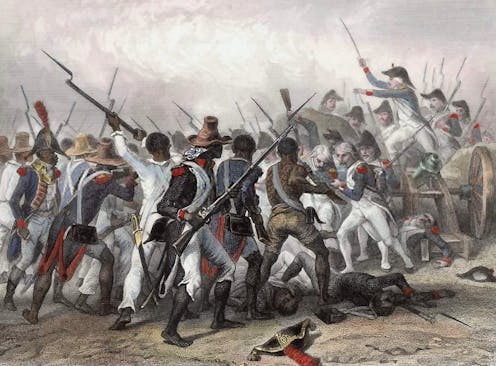
Critics have been raking Ridley Scott’s new movie about Napoléon Bonaparte over the coals for its many historical inaccuracies.
As a scholar of French colonialism and slavery who studies historical fiction, or the fictionalization of real events, I was much less bothered by most of the liberties taken in “Napoleon” – although shooting cannons at the pyramids did seem like one indulgence too far.
I have argued elsewhere that historical fictions need not necessarily be judged by adherence to facts. Instead, inventiveness, creativity, ideology and, ultimately, storytelling power are what matter most.
But in lieu of offering a fresh and imaginative take on Napoléon, Scott’s film rehearsed the well-known battles of Austerlitz, Wagram and Waterloo, while erasing perhaps the most momentous – and consequential – of Bonaparte’s military campaigns.
As with every other Napoléon movie, Scott’s version will leave viewers with no understanding of the genocidal war to restore slavery that Bonaparte waged against Black revolutionaries in the French colony of Saint-Domingue – what’s known as Haiti today.
To me, leaving out this history is akin to making a movie about Hitler without mentioning the Holocaust.
France’s seemingly eternal on-again, off-again war with Great Britain did not change the immediate boundaries of either country. These wars were often fought over land in the American hemisphere and included a historic contest over Martinique, a small island in the Caribbean, whose fate had far-reaching repercussions for slavery.
In 1794, following three years of slave rebellions in Saint-Domingue – events now known as the Haitian Revolution – the French government abolished slavery in all French overseas territories.
Martinique, however, was not included: The French had recently lost the island to the British in battle.
In a 1799 speech to the French government, Bonaparte explained that if he had been in Martinique at the time the French lost the colony, he would have been on the side of the British – because they never dared to abolish slavery.
“I am for the whites, because I am white,” Bonaparte said. “I have no other reason, and this is the right one. How could anyone have granted freedom to Africans, to men who had no civilization.”
Once he rose to power, Bonaparte signed the 1802 Treaty of Amiens with the British, which returned Martinique to French rule. Afterward, he passed a law permitting slavery to continue in Martinique. And in July 1802, Bonaparte formally reinstated slavery on Guadeloupe, another French colony in the Caribbean. Slavery then persisted in France’s overseas empire until 1848, long after his death in 1821.
Meanwhile, in Saint-Domingue, Bonaparte authorized his generals to eliminate the majority of the adult Black population, and he signed a law to reinstate the slave trade to the island.
For the mission to succeed, Bonaparte’s troops would have to contend with a formerly enslaved man called Toussaint Louverture, who had become a prominent leader during the early years of the Haitian Revolution.
After general emancipation, when the Black population had become citizens – rather than slaves – of France, Louverture joined the French army. He went on to play a key role in helping France combat and eventually defeat Spanish and British forces, who had since invaded the colony in an attempt to take it over.
Recognizing his military prowess, the French consistently promoted Louverture until he became the second Black general in a French army – after General Thomas-Alexandre Dumas, father of the famous French novelist Alexandre Dumas. (Thomas-Alexandre Dumas incidentally appears in the film as a character with a nonspeaking part.)
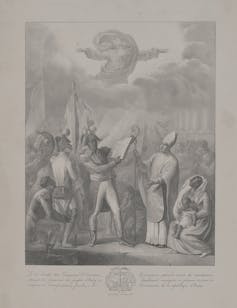
In 1801, as a testament to his growing authority, Louverture issued a famous constitution that appointed him governor-general of the whole island. Yet he still professed fealty to France even as the colony became semi-autonomous.
By then, however, Bonaparte had assumed power as first consul of France – and had made it his mission to “annihilate the government of the Blacks” in Saint-Domingue so he could bring back slavery.
In January 1802, Bonaparte sent his brother-in-law Charles Victor Emmanuel Leclerc to Saint-Domingue with tens of thousands of French troops.
Arrest Louverture and reinstate slavery.
One of the film’s writers, David Scarpa, said Napoléon represents for him “the classic example of the benevolent dictator.”
If that Napoléon ever did exist, Louverture never met him.
In June 1802, Napoléon’s army arrested Louverture and deported him to France. As Louverture wasted away in a French prison, Bonaparte refused to put Louverture on trial. Throughout his incarceration, the guards at the jail denied Louverture food, water, heat and medical care. Louverture subsequently starved and froze to death.
With Louverture gone, Napoléon’s army operated with more bloodlust than ever before. In addition to conventional weapons, his troops fought the freedom fighters with floating gas chambers, mass drownings and dog attacks – all in the name of restoring slavery.
The Black freedom fighters, now calling themselves the armée indigène, led by Haiti’s founder General Jean-Jacques Dessalines, definitively defeated French forces in the historic Battle of Vertières on Nov. 18, 1803. On Jan. 1, 1804, they officially declared independence from France and changed the name of the island to Haiti.
If the filmmakers had included Napoléon’s failed mission to restore slavery in Saint-Domingue, it could have served as a propitious moment to tie the movie back to one of its only coherent arcs: Napoléon’s undying love for Joséphine de Beauharnais, his first wife.
In one memorable scene in the film, Joséphine tells Bonaparte that he is nothing without her, and he agrees.

However, Joséphine’s posthumously published memoir suggests that Bonaparte disregarded his wife’s most prescient counsel. Joséphine wrote that she urged her husband not to send an expedition to Saint-Domingue, prophesying this as a “fatal move” that “would forever take this beautiful colony away from France.” She advised Bonaparte, alternatively, to “keep Toussaint Louverture there. That is the man required to govern the Blacks.”
She subsequently asked him, “What complaints could you have against this leader of the Blacks? He has always maintained correspondence with you; he has done even more, he has given you, in some sense, his children for hostages.”
Louverture’s children had attended Paris’ storied Collège de la Marche, alongside the children of other prominent Black Saint-Domingue officials. Although Bonaparte ended up sending Louverture’s children back to the colony with Leclerc, another Black general from Saint-Domingue who fought to oppose slavery’s reinstatement was not so lucky.
Just before Bonaparte’s troops began their genocidal war in the name of restoring slavery, Haiti’s future king, General Henry Christophe, sent his son, François Ferdinand, to the Collège de la Marche.
After the Haitian revolutionaries defeated France and declared the island independent in 1804, Bonaparte ordered the school closed. Many of its Black students, like young Ferdinand, were then thrown into orphanages. The abandoned child died alone in July 1805 at the age of 11.
Only at the end of his life, during his second exile on the remote island of St. Helena, did Napoléon express remorse for any of this.
“I can only reproach myself for the attempt on that colony,” the defunct emperor said. “I should have contented myself with governing it through Toussaint.”
By including some of this rich material, Ridley Scott could have made a truly original film with historical and contemporary relevance.
After all, Napoléon’s history of trying to stop the Haitian Revolution – the most significant revolution for freedom the modern world has ever seen – has never been depicted on a Hollywood screen.
Instead, hiding behind beautiful cinematography, magnificent costuming and Vanessa Kirby’s masterful portrayal of Joséphine, Scott ultimately produced an unimaginative film about the already well-trodden military successes and failures of the man depicted as having literally crowned himself France’s emperor.
If “Napoleon” doesn’t exactly glorify its main subject, its creators certainly seemed to sympathize with the man whose wars were responsible for more than 3,000,000 deaths, as the film’s final caption reads.
The film did not say whether that number includes the tens of thousands of Black people Napoléon’s army killed in Saint-Domingue.
Marlene Daut does not work for, consult, own shares in or receive funding from any company or organization that would benefit from this article, and has disclosed no relevant affiliations beyond their academic appointment.
Russian president Vladimir Putin has announced he intends to run in the 2024 presidential election. Putin is almost certain to win what would be his fifth term as Russian president.
The news comes as little surprise. Putin has led Russia for 24 years and polls suggest Russia’s ongoing military campaign in Ukraine has bolstered support for him.
In September, Russian pollsters the Levada Center conducted a survey of Russian attitudes toward the war in Ukraine. When asked whether they supported the Russian military’s actions in Ukraine, 73 per cent of respondents said “yes” or “definitely yes.” In February 2022, the month of Russia’s invasion, that number was 68 per cent.
Some might be skeptical of polls coming out of Russia, but it should be noted these figures are from an organization that has been deemed a “foreign agent” by the Russian government. It doesn’t matter who does the polling — the data suggests a majority of Russians support the war effort.
At the same time, Putin’s personal approval rating has remained high, running at around 80 per cent for some time, according to Levada. A more recent poll by Russia’s Public Opinion Foundation indicates around 78 per cent of Russians approve of Putin’s work.
However, there was a drop in support for both the war and Putin in late 2022. In the fall of 2022, the Russian government launched a major mobilization of reservists for the armed forces in response to Ukrainian battlefield successes, first near Kyiv and then Kharkhiv. This led to many young men leaving the country to avoid being drafted into the military.
Russian forces also pulled back from their foothold on the western bank of the Dnipro River at Kherson. Unease with the situation among Russians was reflected in polling numbers during that period, and was tangible on the ground when I visited Moscow and Murmansk in October 2022.
The Russian government’s zero tolerance for public opposition to the war or Putin undoubtedly has some bearing on improved polling. Russia’s defeat of Ukraine’s summer counteroffensive also certainly boosted Russian confidence. Furthermore, the number of Russian soldiers killed in Ukraine remains a closely guarded secret.
However, as I found during time spent in both Moscow and Ryazan in November 2023, many older Russians in particular — from different walks of life — express genuine support for both the war and their president. Why?
The answer to this question lies in part in a combination of Russian government policies and western reactions to the war.
Many Russians undoubtedly accept the government narrative explaining the reasons for the war. Those reasons are not the same as they were back in February 2022, but have morphed into something bigger and more existential.
Back in February 2022, Russia went to war in Ukraine with the justification of protecting the rights of those identifying as Russian in the Donbas, and to prevent further NATO encroachment into the former Soviet space. The “de-Nazification” of eastern Ukraine was also tacked on to these aims.
Defending the rights of ethnic Russians in eastern Ukraine clearly resonated to some extent with the Russian population at the beginning of the war. However, the threat of NATO expansion was perhaps not as powerful an argument for the war back then as the more recent idea that a hypocritical West is out to “cancel” Russian political and economic power.
Money certainly plays a role in maintaining support. The Russian government has increased military wages to keep morale up. As of last September, the minimum monthly wage being offered to those signing up was three times the national average. In June, the government announced it would increase military salaries by 10.5 per cent.
Through their actions, western powers have made it easy for the Russian government to point to western hypocrisy. Unwavering western support for Israel’s war in Gaza has further highlighted that the United States in particular has one set of rules for its friends, and another for its enemies.
A U.S.-backed Israel has been slaughtering civilians at a rate far exceeding anything Russian forces have done in Ukraine. And while western officials were quick to condemn Russian attacks on civilians, condemnations of Israel’s actions have been muted or non-existent.
Moreover, western attempts to isolate Russia economically and culturally have made the Russian government’s narrative that the West is out to cancel Russia easier to sell to the public.
At the same time, blunders by some western governments have also made it easier for Russia to sell the narrative it is fighting fascism in Ukraine. The recent Yaroslav Hunka debacle in the Canadian Parliament was a propaganda gift for the Russian government. Western celebration of Ukrainian units with fascist ties like the Azov Battalion only makes matters worse.
Unprecedented western sanctions aimed at isolating the Russian economy from the world have not succeeded in changing Russian actions in Ukraine.
Instead, increased animosity with the West appears to have pushed Russia to deepen ties with China and other international partners.
Early in the war, Putin touted what he called Russia’s ability to “fully provide itself with natural resources.” While inflation is high, Russian stores remain full and unemployment remains low. The International Monetary Fund did recently lower Russia’s economic growth forecast for 2024, but that forecast still compares favourably to countries like Canada, France, Italy and the United Kingdom.
Palatable or not in the West, Russia’s ability to seemingly resist sanctions and fight off a Ukrainian NATO-backed counteroffensive has contributed to rising public support for the war and for Putin.
Alexander Hill does not work for, consult, own shares in or receive funding from any company or organisation that would benefit from this article, and has disclosed no relevant affiliations beyond their academic appointment.

Have you planned out your holiday gift giving yet? If you’re anything like me, you might be waiting until the last minute. But whether every single present is already wrapped and ready, or you’ll hit the shops on Christmas Eve, giving gifts is a curious but central part of being human.
While researching my new book, “So Much Stuff,” on how humanity has come to depend on tools and technology over the last 3 million years, I became fascinated by the purpose of giving things away. Why would people simply hand over something precious or valuable when they could use it themselves?
To me as an anthropologist, this is an especially powerful question because giving gifts likely has ancient roots. And gifts can be found in every known culture around the world.
So, what explains the power of the present?
Undoubtedly, gifts serve lots of purposes. Some psychologists have observed a “warm glow” – an intrinsic delight – that’s associated with giving presents. Theologians have noted how gifting is a way to express moral values, such as love, kindness and gratitude, in Catholicism, Buddhism and Islam. And philosophers ranging from Seneca to Friedrich Nietzsche regarded gifting as the best demonstration of selflessness. It’s little wonder that gifts are a central part of Hannukah, Christmas, Kwanzaa and other winter holidays – and that some people may even be tempted to regard Black Friday, the opening of the year-end shopping season, as a holiday in itself.
But of all the explanations for why people give gifts, the one I find most convincing was offered in 1925 by a French anthropologist named Marcel Mauss.

Like many anthropologists, Mauss was puzzled by societies in which gifts were extravagantly given away.
For example, along the northwest coast of Canada and the United States, Indigenous peoples conduct potlatch ceremonies. In these dayslong feasts, hosts give away immense amounts of property. Consider a famous potlatch in 1921, held by a clan leader of the Kwakwaka’wakw Nation in Canada who gave community members 400 sacks of flour, heaps of blankets, sewing machines, furniture, canoes, gas-powered boats and even pool tables.
In a now-famous essay titled “The Gift,” originally published almost a century ago, Mauss sees potlaches as an extreme form of gifting. Yet, he suggests this behavior is totally recognizable in most every human society: We give things away even when keeping them for ourselves would seem to make much more economic and evolutionary sense.
Mauss observed that gifts create three separate but inextricably related actions. Gifts are given, received and reciprocated.
The first act of giving establishes the virtues of the gift giver. They express their generosity, kindness and honor.
The act of receiving the gift, in turn, shows a person’s willingness to be honored. This is a way for the receiver to show their own generosity, that they are willing to accept what was offered to them.
The third component of gift giving is reciprocity, returning in kind what was first given. Essentially, the person who received the gift is now expected – implicitly or explicitly – to give a gift back to the original giver.
But then, of course, once the first person gets something back, they must return yet another gift to the person who received the original gift. In this way, gifting becomes an endless loop of giving and receiving, giving and receiving.
This last step – reciprocity – is what makes gifts unique. Unlike buying something at a store, in which the exchange ends when money is traded for goods, giving gifts builds and sustains relationships. This relationship between the gift giver and receiver is bound up with morality. Gifting is an expression of fairness because each present is generally of equal or greater value than what was last given. And gifting is an expression of respect because it shows a willingness to honor the other person.
In these ways, gifting tethers people together. It keeps people connected in an infinite cycle of mutual obligations.

Are modern-day consumers unknowingly embodying Mauss’ theory a little too well? After all, many people today suffer not from the lack of gifts, but from an overabundance.
Gallup reports that the average American holiday shopper estimates they’ll spend US$975 on presents in 2023, the highest amount since this survey began in 1999.
And many gifts are simply thrown out. In the 2019 holiday season, it was estimated that more than $15 billion of gifts purchased by Americans were unwanted, with 4% going directly to the landfill. This year, holiday spending is expected to increase in the U.K., Canada, Japan and elsewhere.
Modern-day gifting practices may be the source of both awe and anger. On the one hand, by giving presents you are engaging in an ancient behavior that makes us human by growing and sustaining our relationships. On the other hand, it seems as if some societies might be using the holiday season as an excuse to simply consume more and more.
Mauss’ ideas do not promote runaway consumerism. On the contrary, his explanations of gifts suggest that the more meaningful and personal the present, the greater the respect and honor being shown. A truly thoughtful gift is far less likely to end up in a dump. And vintage, upcycled, handmade goods – or a personalized experience such as a food tour or hot air balloon ride – might even be more valued than an expensive item mass-produced on the other side of the world, shipped across oceans and packaged in plastic.
Quality gifts can speak to your values and more meaningfully sustain your relationships.
Chip Colwell receives funding from the National Endowment for the Humanities and National Science Foundation. He is affiliated with the Wenner-Gren Foundation and SAPIENS.
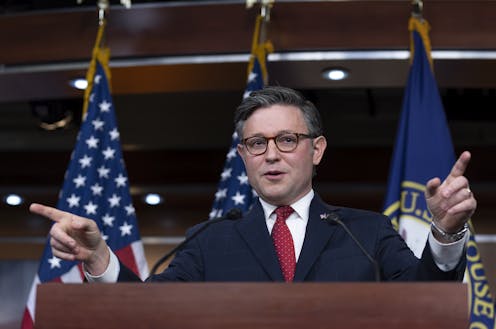
Speaker of the House Mike Johnson has been the subject of considerable media attention following his elevation to the post on Oct. 25, 2023. Since his appointment, news reports have highlighted the fact that he was one of the House leaders against certifying the 2020 election of Joe Biden to the presidency, and that he is known to be stridently anti-abortion and anti-LGBTQ+.
Comparing himself to Moses, in a speech at a gala on Dec. 5, 2023, Johnson suggested that God cleared the way for him to be speaker of the House.
In the words of Public Religion Research Institute President Robert Jones, Johnson is “a near-textbook example of white Christian nationalism – the belief that God intended America to be a new promised land for European Christians.”
As historian John Fea has noted, Johnson is “a culture warrior with deep connections to the Christian Right.”
While it might not seem obvious, one of those connections includes his legal work on behalf of Ark Encounter, the massive tourist site in Kentucky run by Answers in Genesis, or AiG, and its CEO, Ken Ham. Ark Encounter and its companion site, the Creation Museum, propagate Young Earth Creationism, or YEC, which is the notion that the Earth is but 6,000 years old and that the geological formations seen today were formed by a global flood that took place around 4,000 years ago.
The state of Kentucky offers tax incentives for large tourist sites. In 2014, two years before Ark Encounter opened, the state determined that the tourist site was ineligible for these tax rebates. A primary reason for rejection was that all Ark Encounter employees are required to affirm a lengthy faith statement, which, according to Tourism Secretary Bob Stewart, “violates the separation of church and state provisions of the Constitution.”
As an attorney for Freedom Guard, a conservative religious legal advocacy law group, Johnson sued on behalf of Ark Encounter, arguing that in denying the tax rebates, the state was discriminating on the basis of religion. Johnson and the Ark prevailed, and Ark Encounter received the state’s tax incentives.
As a scholar of American evangelicalism, I argue that Johnson’s association with Ark Encounter makes much sense, given the very strong connection between Young Earth Creationism and Christian Right politics. And this connection is old.
In his 2021 book, “Red Dynamite,” historian Carl Weinberg established that for the past century, Young Earth creationists have made the case that evolutionary science makes people behave in “an immoral, ‘beastly’ or ‘animalistic’ way,” especially when it comes to sex and violence.
More than this, Weinberg argues that, for Young Earth creationists, evolution has been understood as the “backbone” of a communist philosophy, a “socialist, Marxist philosophy” that promotes a “spirit of rebellion” in America today.
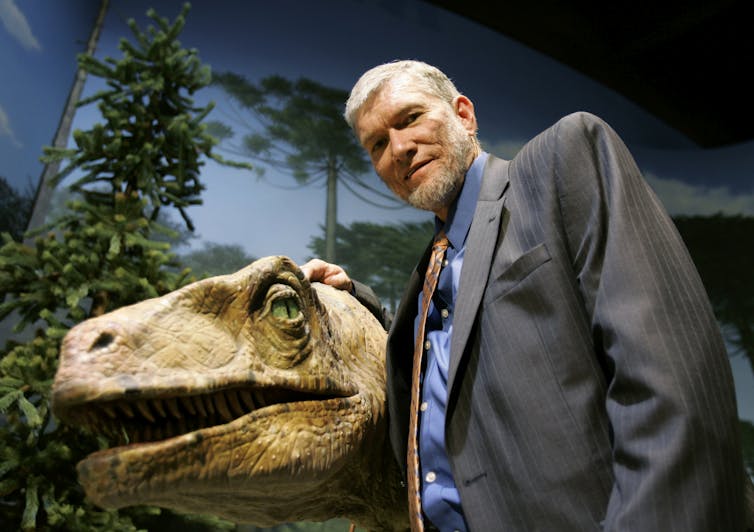
As rhetorical scholar Susan L. Trollinger and I document in our 2016 book, “Righting America at the Creation Museum,” AiG continues this Christian Right tradition through its extensive online presence, its museum and now Ark Encounter.
According to Ham and AiG, “public schools are churches of secular humanism and … most of the teachers are … imposing an anti-God worldview on generations of students.” Sexual immorality, LGBTQ+ activism and the rejection of patriarchy are, according to AiG, signs of the resultant cultural corruption. Ham claims that a once-Christian America – with Bible-believing founders who had no intention of separating church and state – has, since the 1960s, been dragged downward. In his 2012 book, “The Lie,” Ham asserts that this will eventually “result in the outlawing of Christianity.”
In the past few years, AiG has doubled down on its culture war commitments. For example, in March 2021 the AiG Statement of Faith – signed by all employees and volunteers – was expanded from 29 provisions to 46 provisions. This includes article 29, which requires signers to affirm that “‘social justice’ … as defined in modern terminology” is “anti-biblical and destructive to human flourishing.” Then there is article 32, which says that “gender and biological sex are equivalent and cannot be separated.”
Rejecting the dangers of global warming and the notion that governments should intervene to reverse this trend, AiG’s Ham has asserted that “zealous climate activism is a false religion with false prophets.” According to him, climate activists are misled because they begin with human reason and not the Bible, and because they hold to evolution and an ancient Earth.
In a similar vein, an AiG spokesperson blasted mainstream scientists and others who focused on the dangers of COVID-19, arguing that they were simply generating hysteria “about a virus that doesn’t kill very many people at all.” AiG’s CEO lamented on his social media post that “the COVID-19 situation has been weaponized in many places to use against Christians.”
Johnson has effusively praised Ark Encounter as “a strategic and really creative … way to bring people to this recognition of the truth that what we read in the Bible are actual historical events.”
Johnson also shares with AiG’s Ham that government should not intervene when it comes to global warming, particularly given that, like Ham, he does not believe “that the climate is changing because we drive SUVs.”
He also shares with the folks at AiG the conviction that belief in evolution results in immoral behavior. For example, Johnson has blamed school shootings on the fact that “we have taught a whole generation … of Americans that there is no right and wrong. It’s all about survival of the fittest, and you evolve from primordial slime,” and so “why is that life of any sacred value?”
In this, Johnson is echoing AiG authors and speakers. For example, in response to the 2007 shooting in a high school in Jokela, Finland, which left nine dead, including the shooter, Bodie Hodge, an AiG researcher and author, asserted: “So long as evolutionism is forced onto children (no God, people are animals, no right and wrong, etc.) and so long as they believe it and reject accountability to their Creator, then we can expect more of these types of gross and inappropriate actions.”
In short, Johnson’s political commitments fit neatly into the politics of AiG and the Young Earth Creationism ecosystem. This matters politically, particularly given that a significant subset of American evangelicals adheres to Young Earth Creationism.
William Trollinger does not work for, consult, own shares in or receive funding from any company or organization that would benefit from this article, and has disclosed no relevant affiliations beyond their academic appointment.
Experience the vibrant tapestry of Tampa art scene with an exclusive Tampa Bay murals calendar that celebrates some of the most well know art pieces in the area. Each month unveils a stunning visual journey, showcasing the region’s diverse artistic expressions that adorn its streets, capturing the essence of Tampa Bay’s rich creative spirit.
This calendar was made possible through a partnership with local artists, the Tampa Bay Arts Alliance, and Visit Tampa Bay.
Tampa Arts Alliance’s Vibrant Walls team has cataloged more than 150 murals in Tampa thus far, and people just keep painting. Vibrant Walls is the Tampa Arts Alliance project that catalogues the city’s murals. This calendar highlights some of the best known murals that can be found in the area. Creative Loafing has done a great job of photographing the murals as well as explaining the history behind them.
Tampa Arts Alliance is a collaborative nonprofit that looks for ways to advance the arts in Tampa whenever possible. Their vision is for Tampa to be internationally recognized as a vibrant and dynamic city for the arts.
Related: The Tampa Arts Alliance is Putting Tampa on the Map
Here are just a few ways The Tampa Arts Alliance is making sure the Tampa art scene can thrive:
This holiday season the organization is encouraging people to #BUYTAMPAART when shopping for the perfect gift. Don’t know where to start? Here’s a list of local artists and their websites. Decorate your home with the perfect piece from a local Tampa Bay artist!
The post Shop Local! Check Out the Tampa Bay Murals Calendar appeared first on ModernGlobe.

Technology is supposed to make our lives easier. Smart phones provide a palm-size window to the world, enabling us to do almost anything at the touch of a button. Smart homes look after themselves, and virtual meetings mean that for many, time spent commuting is a thing of the past.
So we should have more free time. Time which is now spent sleeping, relaxing or simply doing nothing – right?
If the idea that you have more time than ever before is making you choke on your coffee, you are not alone. There is growing evidence that while digital technology may help us to save some time, we end up using that time to do more and more things.
We recently interviewed 300 people across Europe to understand how they used digital devices in day-to-day life. This research showed that people want to avoid empty periods of time in their lives, so they fill those periods performing tasks, some of which wouldn’t be possible without technology.
Whether it was waiting for a bus, waking in the morning, or lying in bed at night, our participants reported that time which would previously be “empty” was now filled with brain training apps, creating lists of things they should do or try based on their social media feed, and other life admin.
It seems that quiet moments of people watching, imagining and daydreaming are now filled with tech-based tasks.
The growth in digital tasks is happening, in part, because technology appears to be changing our perception of what free time is for. For many people, it is no longer enough to simply eat dinner, watch TV or maybe do an exercise class.
Instead, in an attempt to avoid wasting time, these activities are performed while also browsing the web in search of the ingredients for a more perfect life and trying to develop a sense of achievement.
On the face of it some of these tasks may seem like examples of tech saving us time. In theory, online banking should mean I have more time because I no longer need to go to the bank in my lunch break. However, our research suggests that this is not the case. Technology is contributing to a denser form of life.
Social media may at times inspire, motivate or relax people. But our research suggests people often feel a sense of guilt, shame and regret after filling their free time with online activities. This is because they perceive online activities to be less authentic and worthwhile than real-world activities.
It seems that people still see going for a walk or actually being with friends as more valuable than being online. Maybe if we put down the phone a little more, we would have the time to actually cook those recipes we watch online.
Changing working patterns are also thought to be intensifying work. Home and hybrid working, enabled by video conference technology, have blurred the boundaries between work time and personal time. Now that the office is in the spare room, it is all too easy to think: “I’ll just pop into the study and finish up after putting the kids to bed.”

Digital technologies are speeding up the pace of life. Take email and online meetings. Before they existed we had to wait for responses to voicemails and letters, or travel to places to speak to one another. Instead, we now have back-to-back online meetings, sometimes without enough time in between to even nip to the toilet.
And email creates exponential growth in communications, which means more work to read and respond to it all. Poorly designed technology can also force us to do more work because of the inefficiency that it creates. We’ve all been there, entering information into system A only to learn that because system A and B don’t talk to each other, we have to enter it all twice.
By doing more, we may end up achieving less and feeling worse. As time becomes more pressured, stress, exhaustion and burnout all increase, resulting in greater absence from work.
Reclaiming the time “saved” by technology may require a shift in the way in which we proportion time. To break free of the habit of filling time with more and more tasks, we must first accept that sometimes it is OK to do little or nothing.
In the work environment, employers and employees need to create an environment in which disconnection is the norm and not the exception. This means having realistic expectations about what can and should be achieved in a normal working day.
But developing legislation that enshrines the right to disconnect may be the only way to ensure that technology stops taking over our time. Several European countries such as France and Italy already have right to disconnect legislation.
This specifies that employees are under no obligation to be contactable outside of their working hours, and that they have the right to refuse to take digital work home with them.
It is also possible that technology itself may hold the key to reclaiming our time. Imagine if, rather than telling you stand up and move around (yet another task), your smart watch told you to stop working because you’d completed your contracted hours. Maybe when technology starts to tell us to do less, we will finally regain time.
Ruth Ogden receives funding from British Academy, the Wellcome Trust, the Economic and Social Research Council (ES/X005321/1), CHANSE and Horizon 2020.
Joanna Witowska receives funding from the National Science Centre, Poland, under research project „TIMe experience in Europe's Digital age. Project TIMED is under CHANSE ERA-NET Co-fund programme, which has received funding from the European Union’s Horizon 2020 Research and Innovation Programme.
This article was co-written by Vanda Černohorská as part of the grant project “TIMED: TIMe experience in Europe’s Digital age" (922027/0500) supported by CHANSE and coordinated by the Institute of Philosophy of the Czech Academy of Sciences in Prague.

Ruscism, also known as rashism, russism or simply Russian fascism, is the ideology that forms the backbone of Vladimir Putin’s decades-long dictatorial rule. The term was coined by journalists to describe Russian ultranationalism in Chechnya and Georgia in the late 1990s. However, it began to crystallise into a fully-fledged ideology, complete with an omnipresent symbol – the Latin letter Z – after Russia’s invasion of Ukraine in February 2022.
Ruscist ideology undoubtedly has deep fascist roots. Its foundations were laid by Russian political ultranationalist thinker Ivan Ilyin (1883–1954), whose work Putin has frequently referenced in speeches. More recently, Putin has been inspired by the works of modern far-right thinkers Alexander Dugin and Timofey Sergeytsev. The latter published an article in April 2022 calling for the total destruction of the Ukrainian state and its national identity.
Ruscism, like other forms of fascism, upholds an ultranationalist and dictatorial political system with a strong supreme leader who demands complete obedience from citizens (including all those living in Russian speaking territories).
It does, however, have some distinguishing characteristics with regard to other far-right ideologies. These include a total disregard for objective reality and a strong focus on Russia’s role in world history.
Putin’s principles for governing are very clear, and we have identified six here that define his domestic and international politics.
Ruscism leans heavily on history. According to the propaganda disseminated by Putin and his followers, Russia (then the USSR) won the second world war single-handed. This victory gives Russia a special, perpetual pass for any sins it may commit.
This means that failures such as the Cold War, the Soviet fiasco in Afghanistan, and the brutal, ongoing Russian invasion of Ukraine that began in February 2022 – along with any complications they cause – are irrelevant. What really matters to Putin is that Russia defeated Nazism. For this reason, Putin makes constant references to WWII and the anti-Hitler coalition in his speeches. Indeed, the initial justification given for Russia’s invasion of Ukraine was to liberate and “denazify” the country.
Putin argues that the dissolution of the Soviet Union was the biggest geopolitical catastrophe of the 20th century, and his mission is to restore Russia to its former glory.
To achieve this goal, Putin believes that Russia must demonstrate its military power and demand the respect of the international community. Therefore, the invasions of Georgia and Ukraine, as well as its involvement in Syria, are not isolated incidents, but rather a pattern of deliberate, aggressive political strategy.
The Russian President has implied or openly stated on several occasions that the West must take Russia’s nuclear capabilities into consideration. He has also dropped out of international agreements to control nuclear weapons, and has stationed nuclear missiles in neighbouring ally Belarus.
He believes Russia’s nuclear arsenal will prevent any country from ever daring to directly attack it, and frequently reminds the world of this.
Anyone who opposes Putin is to be tightly controlled, regularly harassed, imprisoned, and, if need be, physically eliminated. The foremost example of this is the lawyer, opposition leader and activist Alexei Navalny, who has been repeatedly imprisoned on spurious charges, and even poisoned with nerve agent novichok.
A lot of other domestic opposition to Putin – such as the communist leader Gennady Zyuganov and, more recently, the populist nationalist Vladimir Zhirinovsky – seems to present little threat to his indefinite rule.
By supporting pro-Russian dictators, such as Bashar al-Assad in Syria or Aleksandr Lukashenko in Belarus, Russia can demonstrate its political relevance to the West. It also indicates loyalty to Russian allies, who can count on Russia regardless of their crimes and policies.
Most of Russia’s allies are not democracies. In fact, Russia has recently made a commitment to strengthening ties with North Korea, a country widely regarded as having one of the worst human rights records on the planet. Supporting countries such as these points to a more classically Fascist element of Putin’s ideology: he wants the world to know that democracy is not the only feasible governing model.
According to Russian propaganda, the West is the only responsible party for the Russian invasion of Ukraine.
Americans seem to be the most useful, universal scapegoat. They are blamed for Ukraine seeking membership of the EU & NATO, and Russian news sources have even gone as far as holding the US accountable for bad weather.
By portraying the West, in its entirety, as an enemy to Russian interests, Putin provides himself with a limitless supply of arguments and justifications for Russia’s continued aggression and invasions.
Attempts to question Russia’s motivations are often met with defensive retorts against Western powers. These have included questioning NATO’s actions in Serbia and Kosovo and highlighting American settler violence against Native Americans.
Ruscism is now, to all intents and purposes, the Russian state ideology. It existed before the current war in Ukraine, but the conflict has catalysed its spread in institutions, and the population at large. Though it is a complex system that builds on centuries of global conflict, its aim is clear: one ideology, one leader, one state, one nation.
Christo Atanasov Kostov does not work for, consult, own shares in or receive funding from any company or organization that would benefit from this article, and has disclosed no relevant affiliations beyond their academic appointment.
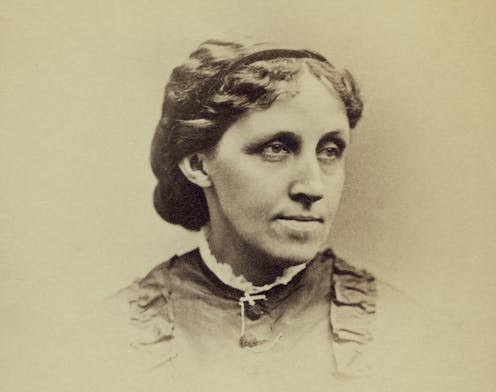
Before Louisa May Alcott published the bestselling “Little Women” in two volumes – the first in 1868, the second in 1869 – she wrote melodramatic thrillers, selling these short stories to magazines to bring in cash for her impoverished family.
On a cold November day in 2021, I was rereading Madeleine B. Stern’s introduction to her 780-page edition of “Louisa May Alcott’s Collected Thrillers.”
In the 1940s, Stern, with her research partner Leona Rostenberg, helped reveal that Alcott had written many of these sensational tales under the pseudonym A. M. Barnard.
But Stern wondered if any other stories written by Alcott were still out there.
For example, in “Little Women,” Jo March – the character who most closely resembles Alcott – also writes short stories to support her struggling family.
“‘A Phantom Hand’ put down a new carpet,” Alcott writes, “and the ‘Curse of the Coventrys’ proved the blessing … in the way of groceries and gowns.”
Stern points out that there’s a related reference in Alcott’s journals – “not to ‘A Phantom Hand’ but to ‘A Phantom Face,’ for which she earned $10 in 1859.”
“But,” Stern adds, “neither the ‘Phantom Hand’ nor the ‘Phantom Face’ has been tracked down.”
At the time, I was a graduate student working on my dissertation. I was on the hunt for pseudoscientific short stories, so the mention of Alcott’s missing tales piqued my interest.
Where was this phantom “Phantom” story? Could I find it?

After searching digital databases, I came across one such story, called simply “The Phantom,” with the subtitle, “Or, The Miser’s Dream, &c.” It had been published in the Olive Branch in early 1860, months after Alcott listed having written “The Phantom” in her journals. But the byline under the story read E. or I. – I couldn’t quite make out the first initial – Gould, which wasn’t a known pseudonym of Alcott’s.
So I went to sleep. Sometime later I awoke with the thought that Gould might be Alcott. What if, along with her several known pseudonyms – A. M. Barnard, Tribulation Periwinkle and Flora Fairfield, among others – Alcott had yet another that simply hadn’t been identified yet?
I cannot say for certain that Gould is Alcott. But I’ve encountered enough circumstantial evidence to consider it likely Alcott wrote seven stories, five poems and one piece of nonfiction under that name.
The publication dates of Gould’s stories – and the outlets where they appeared – certainly suggest Alcott’s authorship.
From the mid-1850s onward, Alcott regularly churned out stories, and yet the record leaves a noticeable gap between spring 1857 and late 1858. In one of Alcott’s letters from the period, she wrote to a friend asking if the magazine Olive Branch would be interested in more of her work. Years earlier, in 1852, Alcott had published “The Rival Painters” in that magazine. Until now, all scholars assumed it was her only story published in the Olive Branch.
In the course of my sleuthing, I found several other pieces that were written by Alcott or had likely been written by her, including a 1856 Saturday Evening Gazette piece called “The Painter’s Dream” and an anonymous Olive Branch story from 1857, “The Rival Painters: A Tale of Florence.”
The latter “Painters” was published in the exact period – and in the same magazine – as many of the Gould pieces. Several other outlets that published Gould also have connections to Alcott. For example, one of the Gould stories appears in the magazine Flag of Our Union, where Alcott later published under the Barnard pseudonym.
But to me, the clearest evidence connecting Gould to Alcott comes from the stories themselves. The name Alcott serves as the last name of the protagonists in two of Gould’s stories. Additionally, “The Wayside” – the name of one of Alcott’s homes – is the title of a nostalgic piece of nonfiction authored by Gould.

The stories also resemble Alcott’s early fiction in important ways. As I argue in one of my dissertation chapters, Alcott pioneered the “sensation” genre. These stories combined elements of sentimental tales with melodramatic thrillers. Instead of taking place in European castles and British landed estates, they were set in the types of places that would have been familiar to the emerging American middle class, such as doctors’ offices and insane asylums. Alcott’s stories show how tensions of gender and class can make those mundane spaces fraught with danger and possibility.
At the same time, there are signs that Gould might not be Alcott. Gould was a common name, especially around Boston. Alcott also kept lists of her stories, and only one of the Gould pieces – “The Phantom” – shows up on those long lists.
However, evidence suggests that the lists aren’t exhaustive – some stories appear on one list but not another – and Alcott refers to stories in her diaries that don’t appear on any lists.
Why would an author like Alcott use pseudonyms anyway?
For one, Alcott was poor. So early in her career she wrote and published for money, and she might not have been particularly proud of everything she wrote. By disguising her name, Alcott could publish in less prestigious venues for a quick buck without worrying about tarnishing her literary reputation.
Even though she was poor, Alcott’s family had wealthy and cultured connections. Among them was Henry David Thoreau who, in “Walden,” disparaged the Olive Branch as one of the papers spreading “the gossip of Boston.” And while Alcott’s own mother often praised her writing, she did so only when the Alcott name was printed in more highly regarded venues, like The Atlantic.
Pseudonyms also allowed Alcott to write about topics she might not have felt comfortable attaching her name to. Many stories written under the Barnard pseudonym depict drug use, reverse gender roles and discuss class conflict in ways that were radical for the late 1850s.
Are there any other Alcott stories that remain unidentified? I would say there almost certainly are. As to whether Alcott used any pseudonyms in addition to the ones that have been identified, that’s less likely but possible.
However, I also hope that the identification of Gould restarts a conversation about authorship, especially for literary figures of the past.
Alcott found herself awash in authorial ambiguity. Her first Olive Branch story, “The Rival Painters,” appeared next to a short essay by the wildly famous and pseudonymous Fanny Fern, who was a master at manipulating public perceptions.
After the blockbuster success of “Little Women,” Alcott published a novel, “A Modern Mephistopheles,” as part of the “No Name Series.” Released by the publishing house Roberts Brothers, the collection featured books written anonymously by famous writers. Readers would try to guess the real authors, but Alcott didn’t reveal she wrote the novel until a few months before her death.
Alcott was deeply embedded in a culture of unknown, and yet guessable, authorship. Anonymity liberated Alcott, Fern and other writers – particularly women – by allowing them to tackle risky topics. But anonymity and pseudonyms didn’t stop people from sleuthing, now or then. Readers delighted in trying to figure out an author’s possible masks, just like I’m doing now with Gould. And it wasn’t just readers: Editors and writers withheld information while at the same time leaving clues. Everyone got in on the fun of hidden identities.
I’ll keep gathering evidence that may either prove or disprove Alcott’s authorship of Gould’s stories. But if I never know, that’s fine with me.
Alcott herself loved acting, and she loved wearing masks, both literally on the stage and figuratively in print. In the spirit of the masquerade, the Gould pseudonym adds to the allure of mystery – and the joy of discovery.
Max Chapnick first presented this research at the American Literature Association Conference in 2022, where he recieved funding from the Louisa May Alcott Society of which he is also a member.